#also bernard blogs out there?
Explore tagged Tumblr posts
Text
((Idk if these are headcanons or just me rambling while I try not to get frustrated at editing photos it’s harder than it looks and I’ve never done it before but a few things did come to mind.
Tim himself says he’s got a body double taking his classes at school
He also admits that, as far as his new boyfriend Bernard is concerned, he’s attending school overseas and really doesn’t like lying to him but he kinda has to
So is the body double attending school in Gotham or overseas?
If the body double is in Gotham, he’s obviously not at the same school as Bernard because I’ve headcanoned that Tim does occasionally attend a couple classes.
Tim and Bernard have movie dates, Tim complains about having to cancel again at one point, so they’re comfortable enough to spend that time together. Do they do voice calls? Do they even know what each other look like? How did they meet?
Because my current theory is that they met in the cryptid forums, struck up a friendship and then flirting and then started dating. And just haven’t done a video call yet))
#ooc#i literally have no idea how to tag this#also bernard blogs out there?#hi can i offer you a caped dork?
2 notes
·
View notes
Text
// out of character
#no but fr ive been reading so much on tim and i feel like i could post more + make this blog more him but idk if anyone still follows this#maybe i should just not care if anyone follows this#anyway i also found out dc fucked up royally by making tim + jon bi and thus making superboy and robin queer without making canon neither#of the ships the fandom loves (timkon and damijon) which just sucks#no hate to my boy bernard but i found timkon a month ago and if anything happened to them i would kill everyone in this room and then myself#red robin#tim drake#only in gotham#batfam#timothy drake#batman#gothamite#gotham rp#gotham roleplay#superboy#timkon
7 notes
·
View notes
Text

oh the seasoms they are a changing....
#👆no they aren't. i'm californian.#i'm manifesting i'm manifesting i'm manifesting 50 degrees#but heyyyyy first real art of the new blog. yippeeeeeeeeeee<3#everytime i draw bernie he looks different I APOLOGIZE. I'M FIGURING HIM OUT.#i think i'm close though. 🙏#also i have officially now drawn both bernie and jotchie in glasses. i'm. smile :)#anyway weeeeeeeeeeee#art#joshua#samir#bernard#werewolf#gay
10 notes
·
View notes
Note
5. is there a muse you really want to try? if yes: what’s stopping you?
Accepting || Questions for Muns
@kryptonianclone

//Oooooo! Good question! Honestly, there are three characters that immediately come to my mind that I would be really interested in writing: Bart, Kon, and Tim. But what's stopping me from writing them are somewhat similar reasons.
Though I have admit I have been writing a KF version of Bart on Discord and been having fun with him, but I'm still nervous about writing him even as I do it. I am worried that I'm not able to get that sunshine, peppy, impulsive personality and voice from him that people love about him, which is partially why RP Bart as Kid Flash specifically. I'm very used to writing serious characters like Thad. Though with KF Bart I do like that he is struggling with the idea of being good enough and taken seriously by others while also having that fun personality and energy. He's got both sides I can play with which I can lean toward so he allows for some of my natural serious voice to seep through.
90s Kon is also in the same vein of being this cool, fun personality, with a specific voice that I'm worried I can't pull off. I'm worried I wouldn't be able to do him justice, or that he won't feel like his character if I'm writing him. Also I'm worried about writing him just because of my lack of familiarity with his comics and history.
Tim is the same. I am less familiar with his history and comics, and personality in the sense of what is displayed in the comics. Also he's so much smarter and competent than I am, which is the big reason why I haven't exactly tried to write him either.

So overall, my worries with venturing out to other characters generally has to do with not knowing their backgrounds or concerns about not doing them justice or accurately conveying their voice, which is why I'm such an intense researcher before I ever commit to writing characters (this is also why my fanfics take so long; I try to pick up on their vocab and speech patterns and general personality). Though this worry is also funny and ironic considering I started Thad's blog by reading wiki articles and googling comic pages he appeared in since I didn't have access to his comics back in the day.
#ask#kryptonianclone#Fun fact: I've ventured out and rp other characters like Bernard Dowd/Bart Allen/ and an AU hero version of Thad (who i really love.)#I've also been thinking about writing Match for a while too. Suicide Squad version of him.#Hero!Thad though really has been getting my brain to spin. I love the concept of inverting Thad's background and asking what if he had the#same sort of background but was created for heroics by a hero family and following in that legacy.#//it's still a tiny bit messed up but also Thad is also a much chipper and a different yet familiar person.#I really just need to set up my multimuse blog#long post#ooc
3 notes
·
View notes
Text
Thank-you sentences for derpsheep behind the cut; weird amnesia Timberkon. (( chrono || non-chrono ))
“You can recognize their heartbeats?” Bernard asks incredulously–that is a very creepy and invasive thing to recognize about someone, much less be passively listening to, what the fuck–and then frowns. “Wait, got back from where?”
“Long story,” Superboy mutters. “Alternate realities were involved. It sucked. But I got back here, and it’s supposed to be right, and there’s people I recognize, but there’s . . . different people, too. And no one here recognizes me. And I thought . . .”
“That you were either totally insane or just stranded in the wrong reality for no discernable reason with no idea how to find the right one?” Bernard assumes.
“That, yeah,” Superboy says tightly. “Definitely that.”
“Good news, I guess, if you are insane, it’s a shared delusion, and if you’re in the wrong reality, so am I,” Bernard says. “Because again, I definitely remember you. And Hawaii. And Superman being dead. And like, all that shit in general. Also you kinda died that one time too? There was a statue, I’m pretty sure. Actually I think there were two.”
Superboy’s smile is tight and humorless, and he digs his fingers into the inside of his wrist. Bernard has no clue how a dude in such severe and obvious distress can look so fucking good about, like . . . literally everything he’s got going on over there. It’s a lot of “everything”, is all. Superboy is a lot no matter what, obviously, but still. Like, extra a lot. Secret bonus levels of a lot.
A lot.
“I mean, there used to be,” Superboy says, and the pained smile he’s wearing turns–bitter, kind of.
Fuck, Bernard feels so bad for this dude. Like so many levels of so bad.
“Don’t take this the wrong way but I need to google some shit,” he says as he digs his phone out. Tim is clearly taking his sweet-ass time in the bathroom, and since he isn’t actually in there waiting for Superboy, it’s gotta be a Bat thing, which usually gives him a good fifteen or twenty minutes of fuck-around time before Tim makes it back with the weak excuse du jour. Or, like, three and a half weeks, one very memorable and kinda fucking awful time that Bernard had spent wondering if jumping into the timestream was how vigilantes ghosted you. “And maybe check some forums or something.”
“I don’t think ‘is this weird dude at the boba shop crazy’ is gonna pop up on Bing, man,” Superboy says, still wearing the same bitter smile. Bernard wonders why he didn’t just go to the Justice League and explain himself to them. Like, they’d probably believe him, right? Or at least they wouldn’t instantly not believe him; they’d check things out or whatever.
Alternately, though: half-Kryptonian full-telekinetic with Lex Luthor’s DNA and Superman’s face who doesn’t even know if he’s crazy or not.
So like . . . that seems like an awkward conversation to have with Superman, maybe, Bernard allows. Or just fucking agonizing and terrifying and wildly, wildly likely to end in one of those stupid misunderstanding-based super-fights and, like, maybe also getting drop-kicked into the Phantom Zone because said stupid fight would be against Superman and that is, apparently, what Superman usually does with supervillain Kryptonians. And probably Superboy is having some very understandable issues about getting drop-kicked out of reality right now, if that’s a concern he’s had. Which–the Phantom Zone isn’t the same thing as an alternate reality, as far as Bernard’s aware, but also what the fuck does he know about the Phantom Zone?
Bernard googles, in quick succession: Superman’s death, the Phantom Zone, and Superboy. He gets a ton of articles and photographs and blog posts with absolutely zero trace of Superboy in a single one of them, a lot of contradicting intel about what the hell the Phantom Zone actually is, and also some blurry candid photos of a ten year-old in ripped jeans and an S-shield hoodie that he’s never seen before in his life.
. . . so that’s weird, yeah, Bernard observes, blinking down at his phone.
“Huh,” he says, brow furrowing. “Hey, should I know this kid?”
“Did you literally just google ‘Superboy’?” Superboy asks, which is notably not an answer to Bernard’s question.
“Obviously, yeah, the entire internet is in my pocket, why would I not do that,” Bernard replies reasonably, still scrolling through random photos of this completely unrecognizable kid. Said kid continues to look like a total fucking stranger and Bernard continues to have zero clue who he is or why he’s wearing the “S”. Another clone, maybe? Like, an even mini-er mini-Super? Bernard can’t see his face all that clearly in any of the pics, still, but he’s at least got Superman’s coloring, it looks like.
“Because Tim would give you shit about it, probably, I don’t know,” Superboy lies, because he very obviously does know. Probably better than Bernard does himself, come to think of it, which is kind of a weird thought but also, like, an obviously objectively true one. Superboy’s spent a lot more time with Tim than he has, even having been, like . . . unrealitied and all.
God, that is still so disturbing a concept, too.
185 notes
·
View notes
Text
Hero Bloggers
Hear me out.
Tim Drake secretly has owned a hero blog since before he had even first started out as Robin and maintained it long after he dropped the mantel for his own, Red Robin.
The blog itself consists mostly of theories and absurd candid shots of heroes he was able to grab discretely through the years. Nothing exposing or anything but still enough to generate interest to make his blog relatively popular.
Through this, he meets Alya Cesaire.
Another popular hero blogger who had the most INSANE theories for heroes he'd ever seen. Nothing Bernard worthy but more so insane because they were almost always right.
She also had extremely well taken videos of hero fights she collected and online interviews with small-time heroes.
The two become friends pretty quickly through their mutual love of blogging about heroes but often bump heads on who their favorite heroes are, how Tim keeps meeting all these heroes before she could even interview them and any theories they have.
With Tim trying his best to steer her away from being right and Alya being headstrong on her ideas and how they couldn't be anything but true.
(For Tim, his favorite hero is Nightwing, but for Alya, it's definitely Black Canary)
Anyways, after blogging together for a while and being annoying with each other, Alya eventually admits to her friend that she and her family are moving to France and she wouldn't be able to contact him for a bit due to the move.
Tim of course is understanding and wishes her well and the time passes as it usually does. He isn't really worried at first about his best friend, too used to her shenanigans as it is but the more time that seems to pass without any word from her, the more concerned he gets.
At some point, after a long case, Tim decides to check in on her and make sure everything is alright. And that's when he sees that suddenly, her account is just gone.
Tim panics.
Not only would Alya have never deleted her blog, but there would have been some traces of it at least somewhere despite it being deleted just from how much people interacted with her account.
But Tim just finds nothing.
Nada. Zip.
He's quick to go searching into Paris as a whole in search of her and runs into an even bigger problem. Paris as a whole city is completely ripped off the map as if it never existed at all.
And there seemed to be no way to get in touch with anyone there at all.
Tim has never been more distressed in his life and he practically pulls his hair out at not knowing anything about where his best friend is beyond the city.
Meanwhile, Alya is having the time of her life!
She's got new friends, a boyfriend, and she now lives in a city with a real life superhero duo and villian!
Yes, it sucked that the villain was an emotional terrorist and Paris is basically under military level lock down until the situation could be taken care of, but now she finally had something to hold over Tim's head.
Interviews and pictures with brand new heroes that Tim had never met!
She had never felt more excited in her life as she posted updates each time on Paris hero situation to her blog.
Alya has absolutely no clue the panic she just put Tim Drake through when he finally manages to bypass through Paris servers on the batcomputer to see a live feed video of her running towards a dangerous monster destroying the Eiffle tower on her blog.
_________________________________________
Or basically
Alya Cesaire and Tim Drake are online besties and (slightly) rival hero bloggers for like over 4 years, and when Paris goes on lockdown due to an emotional terrorist Alya lowkey forgets to tell him she's alive and that there's a reason why she has been basically blipped out of existence entirely
Her bad ig
#dc x mlb#dcxml#maribat#maribat au#maribat community#maribat crossover#ml x dc#batfam#Paris really said YOINK took your emotional support american#i think Alya had a way to contact Tim and kinda just forgot#ya know in the excitement of beating Tim at a new hero#Tim absolutely scolds her for this shit later#mirabat
87 notes
·
View notes
Text

While I delight in Timbern's beautiful Christmas fanarts, I've been cooking up this little attempt at an AU for several weeks now.
So I just imagined Tim trying to get to Bernard to get him safe from the vampire uprising that's been brewing in the shadows, reaching out to him as a civilian and planning to confess to him that he's Robin before taking him to the Bunker under Wayne Tower to keep him safe until they can find the vampire king and get rid of him.
Only the vampire king had gotten to Bernard long before him. Dick just wants his brothers by his side helping him rule the new world he's about to create. Turning Timmy's boyfriend and using him to set him up? That's just sweetening the deal for his brother, after all he wouldn't want to separate him from the person he loves, right?
If I ever stop criticizing DC vs Vampires?, is it because I have been cloned and my clone is managing the blog after getting rid of me 😆 Ok, so I just can't help but think of an AU where Dick hasn't lost 75% of his intelligence by becoming a villain and his desire to have his brothers by his side during the world government was legitimate. (and I will never forgive him for crushing Tim's head like a watermelon without even trying to recruit him to his side).
Also, have you seen that strange and somewhat erotic loyalty of vampires towards their king? That shit never failed to catch my attention.
As if, upon conversion, there was something that was disconnected in people's brains, if humanity had a switch and it simply turned off. They reason, they talk, they think and everything, but there is something so different about them. And that's fascinating.
It reminded me a little of the demons from Sousou no Frieren, who are capable of talking, thinking, planning and a lot of things, but they are not able to understand humanity. A predator that cannot understand its prey.
I think that would be really fun to work with in an AU, but unfortunately I'm too lazy for that lol.
#my art#lorena-art#red robin#tim drake#dc#timber#bernard dowd#reblog my own art#robin tim drake#timbern#vampire dick grayson#dick grayson#dc vs vampires#vampire bernard dowd
509 notes
·
View notes
Note
dude I just love your art, especially anything with Bernard in it! You just make him so pretty! And your like my main sorcery of Bernard fanart because no one else is really all that interested in him but like, he's my little guy, that's my baby, he's the character I'm obsessing over- and your here drawing him!. And just, your art is so beautiful and you draw everyone so well!
Oh and your stephcass is mouth watering too btw! Wow you draw them so, just, wow! And I saw the dragon prince stuff you drew, and it's so awesome too! Currently re-watching it atm and it was such a a lovely surprise to scroll through your blog and see Callum and Rayla!
Anyways I love your art, wish I could eat it, like it just looks so good I need to like grr idk it's just amazing! And yeah I want you to know I appreciate your Bernard, I love him, and I love you, and yeah I just want to let you know I think your blog is really neat! I hope you're having a wonderful day/night!
shkfhwoah you're too nice, have a bearnard
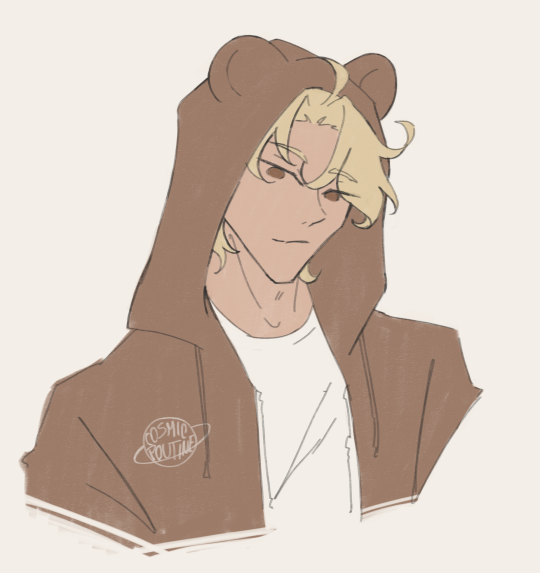
the bernard loving community is small and we're all a bit crazy, but its fun here.
also PLEASE we need more people in the tdp fandom, im gonna get annoying about it again when the new season comes out.
159 notes
·
View notes
Text
Study Break
18+ || MDNI || Content Warnings: SMUT, characters aged up, established relationship, language, praise kink, thigh riding, lil bit of breeding kink, semi public sex I think that covers it all
Word Count: 1480 exactly
Repost from original blog @/pluvpluvpluv
Sebastian Sallow x f!MC
A/N: Happy Thirsty Thursday :) This was written in one sitting and not edited at all. I read through it once before going “yeah post it”
Part Two Here
MC was ready for summer. Summer meant NEWTs were done and she could take a month or so off to celebrate and relax before diving headfirst into her next adventure. She had spent the last two summers under an apprenticeship with Fatima Lawang, making the trip from Feldcroft to Keenbridge every day to study and learn business from someone she truly looked up to. She would be opening a small apothecary in the hamlet she now called home. It was a wonderful location, since she knew Bernard really stuck to selling beast byproducts and plants. She wouldn’t be encroaching on his market, and she could also source ingredients from him. It was going to be, thankfully, a mutually beneficial existence.
She had moved to Feldcroft at the end of their fifth year. Sebastian had nowhere else to live over the summer months, she really had nowhere to live over that time, and neither wanted to be alone. So, when that first year had come to an end, she just followed him home. He had started courting her about halfway through that summer. She had accepted and they had practically lived together like a married couple ever since.
Before she could get to the summer and enjoy her newfound freedom with the love of her life, she had to pass the NEWTs. In order to get her apothecary license, she needed to score high in Potions and Herbology at the very least, but that wasn’t going to be enough for her. The reputation of saving the wizarding world at fifteen years old meant she was expected to do exceedingly well on all of her NEWTs, and she was determined to do so.
She had taken up residence in one of the more secluded corners of the library. It always ensured that MC wouldn’t have to share the table and she could have all of her books open and spread out. Only a select few people knew of where she hid out to study, which limited the interruptions. Except in the case of her boyfriend.
She didn’t know how long she had really been studying when Sebastian finally sat beside her. She didn’t even look up from rereading a paragraph she had already read ten times before. She still retained nothing.
“MC. Love, you missed lunch. I brought you some food.”
“Thanks Bash. I’ll eat it in a minute. I just need to understand what this page is saying.”
He set the plate down and moved the book.
“Considering it’s well past lunch and I didn’t even see you at breakfast, I think you can’t understand the page because you’re hungry. Eat and take a break.”
MC glared at him, debating whether or not it would be worth the argument since they were both the most stubborn person the other had met. That train of thought was interrupted by a rather loud growl as she was betrayed by her own stomach. She ate the food that he brought her without further complaint.
While she ate, Sebastian sat beside her and scanned over the tomes she had laid out on the table. She was paying more attention to him instead. The way that his eyebrows furrowed when he was focused on a paragraph in one of the books and the way his lips moved silently with the words. She focused on his hands as he turned the page and the way that the muscles in his exposed forearms flexed even with that small movement. She could feel herself growing hotter by the second, and it led to the realization that she and Sebastian hadn’t been intimate in nearly three weeks. It could’ve been a record, honestly. Even before he was courting her, after they took each other’s virginities that first summer in Feldcroft, they hardly went more than a couple days without going after each other. The joys of two students living with no chaperone.
“I can feel you staring holes in the side of my head, MC. Have you finished eating? Do you want me to read to you to see if that helps you understand the material better?”
The way he cared for her had also always been one of her favorite things. She had never been good at keeping herself in check, but Sebastian always did his best to make sure she didn’t overextend herself.
“I—uh it’s mostly gone. But I was thinking about something else.”
“Were you? Care to share with the class, darling?”
“I could use your help. Just in a different way.”
He looked at her curiously for a moment before it seemed he registered the look on her face and his expression grew more heated.
“Have you been thinking too much? Do you want to turn that brilliant brain off for a minute?”
His tone was condescending, and while it would normally agitate her when he spoke to her that way, this time it felt different. She nodded slowly, her eyes not leaving his own while a smirk grew on his face.
“Do you remember over the winter holiday, you told me about how one of the girls had talked about grinding on a pillow when she didn’t want to do things herself and I made you do it for me? We don’t have a pillow here, but I bet I could have you grinding on something else and feeling as good as you did that night. Come sit on my thigh, darling. We’ll see if you can ride me like you rode that pillow. Maybe you’ll make just as big a mess on me.”
As she settled in on his lap, she was grateful she had opted for a skirt instead of one of the few outfits she had with pants. The back of the skirt that draped over her boyfriend’s knee would hopefully help hide what they were doing if anyone were to stumble back and find them.
She gave an experimental roll of her hips, and she felt Sebastian’s thigh flex beneath her. MC let out a shaky exhale as she did it again. The thin fabric of her knickers and the coarse fabric of Sebastian’s quidditch pants provided the most delicious friction to her clit. Sebastian’s large hands settled on her hips beneath her skirt, the feel of his fingertips on her bare skin lighting her nerves on fire.
“Make sure you stay quiet. Don’t need anyone hearing how I’m helping you study,” his voice purred, the effect going straight to her core.
As she grew more confident, her pace picked up. Sebastian helped, tensing his thigh and slightly pushing her hips down when she rolled them to make sure that the bundle of nerves she was focused on didn’t go a second without feeling something.
“That’s it, darling. Use me. Grind that needy little cunt on my thigh.”
MC gasped softly, biting her lip as the familiar tension in her lower stomach began to build. She was able to keep her volume down, but she couldn’t keep herself from whining and whimpering completely.
“Bash. Oh gods. I-I’m~”
“Keep going, darling. I can feel how bad you need it. That pretty pussy is drooling through my trousers. You’re making such a mess for me, my good girl. Go on. Cum on my thigh. You can do it, honey.”
With his encouragement and permission, she felt herself giving into the pleasure as her orgasm hit. Her hips stuttered, but Sebastian kept her in rhythm. She registered his low moan too, her chest heaving as she started to come down from her high.
MC’s hand moved to where she assumed she’d find Sebastian’s bulge, hard and aching for the attention she wanted to give it. Instead, her hand landed on a warm, wet patch on the front of his trousers.
“Sebastian Sallow,” she spoke his name low and soft, her frazzled brain slowly putting the pieces together as she looked up at him. “You came in your pants. Untouched. Because of me?”
The boy’s freckled cheeks flooded with color as he blushed. Her normally suave boyfriend seemed embarrassed by this turn of events.
“I may have. You didn’t see yourself. Or hear yourself for that matter. I didn’t realize it was going to happen until it just…happened.”
“That is one of the hottest things you’ve ever done. If we can sneak down to the library floo flame without getting caught, we can make it to the ROR. And I can give you something else to cum in.”
He let out a dark chuckle, looking at her with blown pupils.
“You think this is a game, MC? Hmm? Merlin, I’m gonna get you so fucking pregnant.”
Her eyes widened, and she couldn’t stop the giggle that fell from her lips. She was still giddy as she pulled him down the stairs and towards the floo flame on the back wall.
Thank Merlin for study breaks.
#sebastian sallow#sebastian sallow fanfiction#Sebastian sallow smut#Sebastian sallow x mc#Sebastian x mc#hogwarts legacy#hogwarts legacy fic#Sebastian sallow fic
57 notes
·
View notes
Text
My Commentary on Tim Drake: Robin
Because it’s my blog and I can do what I want
Starting off strong with the panel that made TimKon shippers go crazy

Ahhh! I love them calling eachother the Batfam it makes me happy

Then look at how small Bart looks

Small boy
A couple commentaries not connected to any particular panel but I adore the art style and I’m so happy Tim and Stephanie worked things out.
But I think Tim might have a type

TimKon shippers, TimBern Shippers and Platonic Tim and Steph fans somehow all got fed with this Pride Comic
People say Jason is the book nerd when Tim Spends this whole story recognizing and remembering the plots of detective novel not to mention he recognizes that he lost four books and figured which ones they are not to mention just the collection of book he treats like his most precious items. Like I acknowledge Jason and Jane Austen and love it but he should not be the only one joked about being a book nerd.
These clone escue thingys show up and Tim’s thoughts about them are so interesting.

I adore that even as he’s fighting them he’s saying praise for all of them, though he’s got the most for Dick. And the first read through I thought he didn’t compliment Jason and that made me sad.

Close up on Damian’s because you can’t really see it in the full page pic and the my baby brother just really got to me. I am very susceptible to Batfam moments
But Gosh even knowing they’re not his actual family it’s got to hurt to hear them confirm all his worst fears of never measuring up.
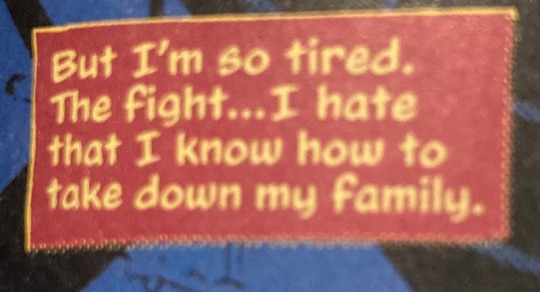
Well like father like son I guess. It’s not like Batman hasn’t figured out how to take down almost any hero he meets.

Little does Bernard know.
I love the TimBern in this. Their relationship is still developing, it’s clear that Bernard is comfortable in it from the start of the volume but Tim has his doubts of where they stand, of whether this is a good idea because he’s just dragging Bernard into his mess. But Bernard has his own messes and struggles and they can just be with eachother through all that
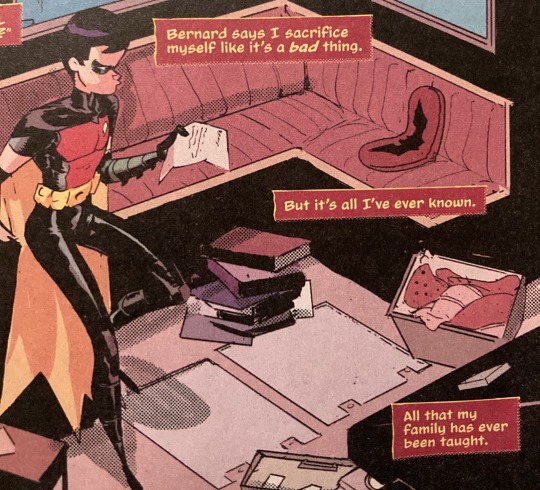
Tim. Timmy boy. That’s not a good thing. You should learn how to have some more self preservation, just because your family are all self sacrificing doesn’t mean it’s the healthy way to be.

Why is Superboy’s biggest fan what Tim finally responds to? Also why does Bernard call him that? Is Tim talking about him all the time? Also I love that Bernard calls him his boy wonder once again little does he know. (This is another scene I’ve seen TimKon fans go crazy for)
That’s the last picture on this post as I’ve hit the limit but the book was very good! I loved the villian, loved how they explored Tim. Love the Tim Bern. Tim coming to the realization that it’s ok not to know who he is yet is amazing. He’s figuring things out and that’s ok.
#dc tim drake#red robin#tim drake#dc#dc comics#timbern#timkon#bernard dowd#dc bernard#batfam#batfamily#anaylsis#robin dc#robin#dc robin#robin tim drake
111 notes
·
View notes
Text
Summary of the first 5 months of this blog or Navigation v2
Today is a significant date for several reasons: it is Tony's birthday, the blog now has 200 followers and the number of posts has reached 160.
Because of the last reason, the time has come to summarize the results of our research over these months.
So far we found out:
Which Tony is the real one: Alter Ego, Kid, Teenager, Big man in a suit of armor, Gryffindor
Details about his childhood: Facts, Own will, Inner child, Bravery, When he met Rhodey
That he is an introvert: MCU, 616, Socially awkward, Absent-minded
His natural habitat: a Lab
What makes him happy: Science, Kids, Relationship
What he accomplished: Achievements, Marksman, PhDs
That he is not a narcissist and his self-esteem is not high: Easy test, 616 Low Self-esteem, Lack of ambition, Not High Self-esteem
He is actually a very strange billionaire: Part 1, Part 2, Part 3, Comfort, Food, Chores
That he cared for others: Compound owner, Barton's farm scenes, Useful person, What if, Peter's clothes
Who was a true friend: Steve, Bruce, Stane, Coulson, Nat and Clint, Pepper, Happy and Rhodey: Part 1 and Part 2, BFF
That Tony sometimes says things about himself that are the opposite of reality: "I'm fine", "Playboy"
That he doesn't have a drinking problem in the MCU: Conclusion with its own navigation
About relationships with Steve Rogers: Did he hate him? Role Model Part 1, Part 2, War and Peace, Saving Captain Rogers
That Tony is bisexual: Proof, FrostIron
And submissive: Proof
He is a dog at heart: Why, Saint Bernard
But likes cats: Cat person
Who is the nicest guy of the OG6: Data on: Tony ("My faults", "Thank yous", "Sorrys: Part 1, Part 2"), Steve, Thor, Bruce, Natasha, Clint Who thanks the most Who apologizes the most Who admits his/her fault the most Results
What happened during Civil War: The Accords, Recruiting Peter: War crimes, Part 1, Part 2, Part 3; Fight Part 1, Part 2, Tony saved Bucky
And what could have happened instead: B.A.R.F.
How Tony is different from Thor: Sakaar
How Tony made his decision about the Time Heist: Part 1, Part 2
That MCU is not 616 and how Multiverse works: MCU is not 616, FAQ, Multiverse
We also played a game "Tony or Steve" and found out some interesting facts.
Some additional topics that were discussed:
War, military and weapon manufacturing: Iron Man 1 villain, Hypocrisy, We are all profiteers, Pros and cons of Tony being weapon manufacturer
Some criticism: Tony's inappropriate jokes, Womanizer?
Thanos: His not-so-good plan to save the universe
Steve: Blaming others, Why Bucky is not the new Cap
Pepper: And her sexual life with Tony
Clint: Has superpowers
Howard: His obsession with shields
P.S. Tumblr does not allow to add more than 100 links, so some less important posts are skipped and added to this post.
37 notes
·
View notes
Text
Tenshō Daijin: the many guises of medieval Amaterasu (part 1)

I’ve been working on this article on and off since late 2021, and it’s the longest one I’ve published on my blog so far (some of my wikipedia contributions are bigger, but that’s a separate matter). In fact, it's so long I have to split it into two due to limitations of tumblr's post editor.
When most people speak of “Japanese mythology”, 99% of the time they effectively think just of the Kojiki and Nihon Shoki (with some night parade scrolls sprinkled in, maybe, even though that’s not really mythology, but Edo period popular entertainment). The goal of this article is to challenge this incorrect view, and to shed some light on the mythology of the Japanese “middle ages” - roughly between the 11th and the 16th centuries. I decided to use Amaterasu as the main topic, as it’s hard to think of a better way to showcase how much mythology remains outside the general perception than using a figure who, at least at first glance, is well known as an example. From Brahma longing for a friend to Yang Guifei surviving own death, I’m sure everyone will find something new here. Myths obviously aren’t all that will be covered here, though. I’ll also discuss the theological doctrines which flourished in the middle ages, with a particular emphasis on honji suijaku, their social context, and more. You will be able to find out what rituals focused on Amaterasu had to do with Enma and Taizan Fukun, how economic woes of the Outer Shrine of Ise impacted Brahma’s role in Japan, why some secrets existed only to be deliberately revealed, and more.
Kami and Buddhism
In order to discuss the development of Amaterasu’s character and her associations with other figures through the middle ages, as well as the myths which developed as a result, I’ll first need to summarize the nature of interactions between kami and Buddhism through the Nara, Heian and medieval periods. I’m specifically saying kami, as opposed to Shinto, for reasons which will become clear later. It seems that at first the relation was rather standard as far as early interactions between Buddhism and preexisting religious traditions in areas where it was introduced go. Mark Teeuwen singles out Tibet and various kingdoms corresponding to parts of present day Myanmar as examples particularly similar, though obviously not identical, to early Japan. The parallel developments concerned the Bön faith in the former and the beliefs pertaining to the nat in the latter. The early sources appear to indicate that kami were envisioned as beings who need to strive towards enlightenment themselves. Recitation of sutras was described as a way to bring them closer to that state. However, some rather quickly started to be viewed as active protectors of Buddhism. As early as 741 Hachiman was already regarded as such, for instance. Additionally, combinative “shrine-temples” already existed in the same period too, attesting to a fusion of Buddhism and preexisting tradition.
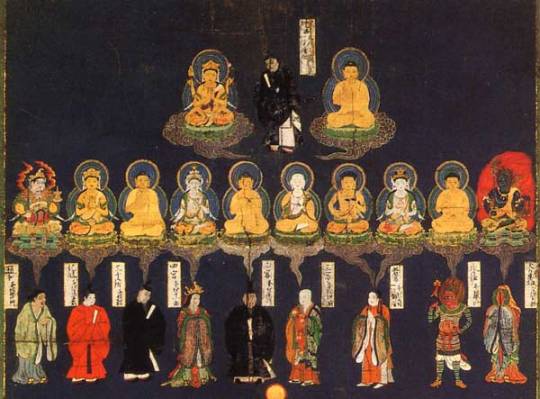
A schematic representation of some examples of the honji suijaku from the Kasuga mandala (wikimedia commons)
A breakthrough occurred in the ninth century, with the development of honji suijaku (本地垂迹) - the theory on kami being “traces” or “emanations” (suijaku) of Buddhist figures, referred to as “original sources” (honji). Similar theories regarding Daoist figures were at times advanced by Chinese Buddhist scholars as early as in the fifth century, so it was hardly an unparalleled development, though its scope was fairly unique. By the end of the Heian period, honji suijaku became the default mode of understanding kami.
A common misunderstanding today is that honji suijaku meant exact correspondence between a single Buddha and a single kami. In reality, what it created is a “fluid pantheon”, to borrow the title of one of Bernard Faure’s books dealing with this phenomenon. Connections between specific kami and Buddhas (or bodhisattvas) certainly were often established. However, that was not all.
Kami could be connected to other kami, and Buddhas to other Buddhas; and on top of that both groups belonged to an elaborate network which also included devas, wisdom kings, astral deities, legendary heroes and historical figures from various countries (for example Daoist immortals), and beings which defy classification altogether. In Keiran Shūyōshū (溪嵐拾葉集), the notion of honji suijaku is even extended to silkworms (their honji is Aśvaghoṣa). Multiple identifications could coexist, sometimes in the same sources. On top of that, individual figures could change classification depending on context.
The new theological ideas also lead to the formation of new myths, collectively referred to as chūsei shinwa (中世神話; “medieval mythology”). As summarized by Sujung Kim, this term encompasses both the myths which arose in the Japanese “middle ages”, the Kamakura and Muromachi periods (1185-1600), and modern study of them. A closely related, though more narrow, term is chūsei nihongi (中世日本紀), which refers specifically to reinterpretations of preexisting classical myths, for example Nihon Shoki, from the same times.
One of the primary goals of the new myths was to create a metaphorical bridge between Japan and the lands described in Buddhist literature transmitted from China, Korea and beyond. Sutras and other literature were often set in fabulous distant kingdoms or in supernatural realms. At the same time, the material reality of Buddhism tied it to local institutions and landscape. As a result, the local was imbued with a new, universal meaning.
As Mark Teeuwen put it in his article The Buddhist Roots of Japanese Nativism, medieval literature “allowed a local warlord to pose as a golden cakravartin, a local mountain to take on the guise of the cosmic Mt. Sumeru, a local deity to embody an aspect of the World Buddha, and a local rite to aspire to the universal aim of bringing salvation to all sentient beings.” At the same time, the universal gained a local dimension, making it easier to grasp and more approachable.
However, that was hardly the end, more like the beginning - yet another prominent change which occurred over the course of the 12th and 13th centuries resulted in the formation of a new belief: select kami were in fact not emanations of secondary importance of Buddhist figures, but direct representations of enlightenment. These developments eventually culminated in what is sometimes described as “reverse honji suijaku”: Buddhas and bodhisattvas were merely manifestations of primordial kami, not the other way around.
The motivations behind the development of these ideas are not clear. While especially in the past it was commonly assumed that they represented the beginning of a “pristinely Japanese” spirituality reasserting itself against “foreign” Buddhism, most of the theologians involved were Buddhists themselves, or at least enthusiastically drew inspiration from Buddhist sources. Mark Teeuwen and Fabio Rambelli suggest they might have been motivated by a desire to take Buddhist theology to logical extremes in order to investigate the nature of reality before the emergence of the first Buddha and the current kalpa.
Furthermore, in addition to lofty theological speculation material motivations might have been at play. Many of the advocates of reverse honji suijaku might have been so-called “shrine monks”, tasked with maintaining the shrine parts of religious complexes. Possibly their need for broader recognition and greater authority made them keen on such theological reversals. This is ultimately speculative, though.
Curiously, reverse honji suijaku arguably might have led to the creation of Shinto in the modern sense. While the phrase 神道 has a long history, and it is applied to intellectual and religious movements active in the middle ages in modern literature (for example, the treatises of a certain priestly family I’ll discuss are often called “Watarai Shinto”), there is no strong evidence that it was commonly understood as shintō in the modern sense - a distinct religious tradition - predating an explicit statement in a treatise from 1419 written by the Tendai monk Rysōhen dealing with these topics. In the earliest sources the default reading was jindō, referring not exactly to a distinct system of beliefs, but rather to a “realm”of kami ultimately existing in Buddhist context. While Shinto did eventually develop into the tradition which came to define the kami, through the middle ages and the Edo period which followed, honji suijaku was the dominant paradigm, and permeated all spheres of society.
The early history of Amaterasu: sun, textiles and longing for companionship
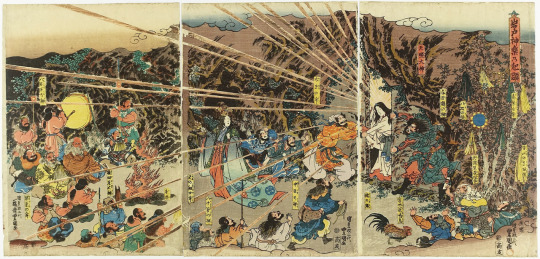
An Edo period painting of Amaterasu emerging from the cave, by Kunisada Utagawa (wikimedia commons)
While the explanation of the basic nomenclature and a crash course in interactions between Buddhism and kami is now out of the way, before I’ll be able to move on to the impact of the medieval ideas on Amaterasu I need to briefly summarize her earlier history.
Through the article I will simply use the name Amaterasu consistently. However, it should be noted that the standard form of the name, 天照大神, in the middle ages and in the Edo period was often read not as Amaterasu Ōkami, but rather as Tenshō Daijin, in accordance with on’yomi or “Sino-Japanese” sign values. Therefore, don’t be surprised that this is the version used in titles of historical works mentioned. As a curiosity it is worth mentioning that this is actually the reading used fairly consistently in the first western source with reasonably reliable information about Amaterasu (unless I missed something even earlier), Engelbert Kaempfer's History of Japan from 1727.
On a similar note, I generally stick to describing Amaterasu as female. However, it needs to be pointed out that through the middle ages and in the Edo period male Amaterasu is also attested, depending on the source either replacing the female version or coexisting with her. Some modern authors go as far as speculating if Amaterasu wasn’t originally seen as male prior to being redefined as female, but this is not really fully provable. The existence of a tradition according to which Amaterasu manifested in male form is already mentioned by the Tendai monk Jien (1155-1225). There are also sources providing ambiguous information about Amaterasu’s gender. In at least some cases such phenomena were a result of identification with figures either regarded as male or portrayed as androgynous in art, as I outlined in a recent article discussing the case of Amaterasu and Uho Dōji (who won’t be brought up here in any meaningful capacity, since I'm not going to focus on the Edo period). It’s not really possible to make a blanket statement on this matter, though.
Additionally it’s important to bear in mind that identification between two figures could transcend the gender of the parties involved. As you’ll see later, there were even cases of Amaterasu’s identification with a male figure actually resulting in traditions particularly strongly emphasizing her typical gender.

The Inner Shrine at Ise in 2008 (wikimedia commons)
Throughout her entire history Amaterasu has been associated with Ise and its Grand Shrine. According to the Nihon Shoki, that’s where she originally descended from heaven to earth, and where she later returned in order to be enshrined. The term “Ise Grand Shrine” actually refers to a complex centered on two major shrines, though, and only one of them, the Inner Shrine (内宮, naikū), is dedicated to Amaterasu. The kami of the Outer Shrine (外宮, gekū) is instead Toyouke.
The earliest history of Amaterasu is effectively unknowable due to lack of available sources. While she does appear both in the Kojiki and Nihon Shoki in a central role, both of these works only date to the eighth century, and their historicity is often at best dubious. When exactly was her shrine originally established is a matter of debate: supporters of treating Nihon Shoki literally argue for 4 BCE (during the reign of the legendary emperor Suinin), but historians and archeologists favor more vague dating to either the fourth, fifth or seventh century. The earliest detailed records of specific religious ceremonies at Ise can only be found in an administrative protocol compiled in 804.
Historically it was quite popular among researchers to essentially assume being a personification of the sun is all there ever was to Amaterasu’s character, and that she derives her importance entirely from her solar role. Today this view is no longer accepted quite as firmly, and it is even sometimes questioned if this was necessarily her original function, though this is ultimately neither entirely provable nor fully relevant here.
Obviously, the classical Amaterasu also served as a royal deity presented as an ancestor of Japan’s imperial lineage. She was also treated as a symbolic source of its authority by extension of her role as a heavenly ruler commanding the kami. This is an example of the well documented phenomenon of clan kami (氏神, ujigami). However, based on archeological data Ise was not particularly important early on in Japanese history, and the area around it was sparsely populated as late as in the seventh century On top of that it would appear that, if the early texts are to be believed, emperors actually had an ambivalent relationship with her. It has been suggested that her classical position was only established during the reign of emperor Tenmu in the late seventh century, perhaps due to his personal connection to clans from the Ise area.
It’s important to stress here that on multiple occasions in history, in particular recent history, the connection between Amaterasu and emperors was channeled to nationalist and imperialist purposes. For instance, the Japanese colonial government in Korea funded the construction of a complex enshrining Amaterasu and emperor Meiji in the 1920s, and subsequently legally obliged students (among others) to attend ceremonies held there to foster loyalty.

The Outer Shrine in 2015 (wikimedia commons)
A key moment in the early history of Amaterasu was the introduction of the kami Toyouke (豊宇; literally “abundant food”) to Ise. A legend about her arrival is preserved in the aforementioned administrative protocol from 804. According to it, Amaterasu appeared to emperor Yūryaku (second half of the fifth century, if his historicity is to be accepted) in a dream to let him know that she is distressed and lonely, and on top of that can’t receive offerings of food according to proper protocol. She explained that the only way to solve all of these problems is to bring her a kami responsible for divine food (御饌津神, miketsu kami), Toyouke, who is to be found in Hiji no Manai in the Tanba Province. Thanks to this precise guidance, the emperor was able to instantly solve the problem, and Toyouke was moved to Ise, where she symbolically took the responsibility for food offered to Amaterasu.
Presumably, the legend contains at least a kernel of truth, and Toyouke was initially enshrined in a facility meant to fulfill a specific ritual role for the Inner Shrine, which in time grew to rival it in size and importance. Save for these details, much about the early history of Toyouke is even more unclear than in the case of Amaterasu, though. She is only mentioned in passing in the Kojiki under the name Toyoukehime no Kami (豊受姫神) in the account of the birth of Wakumusubi no Kami (和久産巣日神), one of the many kami who came into being as a result of Izanami’s death. However, this passage does not provide any information about her character, it merely states that she is Wakumusubi’s child. This tradition was of limited, if any, interest to the Outer Shrine clergy through the middle ages, as I’ll later demonstrate.
While Wakumusubi also appears in the Nihon Shoki, though with a slightly different genealogy, Toyouke is entirely absent from this work. You can find a claim on the contrary in Michael Como’s Weaving and Binding. Immigrant Gods and Female Immortals in Ancient Japan, but he essentially treats Ukemochi as identical with Toyouke and asserts the myth about Tsukuyomi killing the former is effectively about the latter. It doesn’t seem like any subsequent publications picked up this idea.
The final early source of information about Toyouke is the Tango no Kuni Fudoki (丹後国風土記; “Records of the Tango Province”). It presents her as one of eight “heavenly women” (天津乙女, amatsuotome) who at some point arrived at a spring near Mount Hiji to bathe. An old couple stole the clothes of one of them, rendering her unable to return to heaven. They subsequently ask her to become their daughter, since they have no children. She agrees, and for ten years lives with them, brewing sake which could magically heal “ten thousand ills”. The old man and woman prosper thanks to her. However, they eventually decide to tell her that she is not really their child, and should go back to heaven. She tells them that she has lived among humans for so long this is not an option for her anymore, and leaves in anger. She only calms down after reaching a different village, Nagu, where she is eventually enshrined under the variant name Toyoukanome no Mikoto (豊宇賀能売命). Due to involving a heavenly being having to stay on earth due to her clothes being stolen, this myth has been compared to the better known Hagoromo. Michael Como also argues that it might reflect the perception of Toyouke as a Daoist immortal (hence her ability to bew something akin to the fabled Daoist alchemical elixirs meant to prolong life), similarly to how the legend of Urashima Taro does. While I found his Nihon Shoki argument somewhat dubious as I said, I think this is an interesting point which warrants further study. Similar possibility about Toyouke’s character has been suggested by Bernard Faure too.
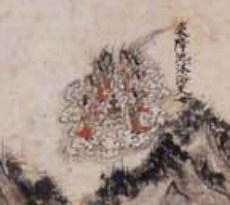
It’s also worth noting a possible reference to the Tango no Kuni Fudoki myth has been identified in a painting of the two shrines of Ise from the collection of Shōryakuji, a Buddhist temple located in Nara (seen above; screencapped from Talia J. Andrei's Mapping Sacred Spaces: Representations of Pleasure and Worship in Sankei Mandara, for educational purposes only). It depicts eight female figures standing on a cloud around a container used to make sake in the proximity of the Outer Shrine.
Amaterasu and Buddhism: the ambivalent beginnings
Early sources pertaining to Ise discussed in the previous section are invaluable when it comes to Amaterasu’s position and her connection with Toyouke, but they don’t really shed any light on the development of associations between her and Buddhist figures. Quite the opposite - they indicate that around the year 800, even basic Buddhist terms like “pagoda”, “monk” or “sutra” were considered taboo (忌み, imi) by priests of the Inner Shrine, much like these pertaining to conventional sources of religious impurity like violence, death or illness. However, Mark Teeuwen notes at the same time these very priests most likely took part in Buddhist ceremonies themselves, and there is even some evidence that in the eighth century a Buddhist temple existed in Ise.
The reasons behind the implementation of the taboo were likely largely political, rather than strictly religious. For context: in the second half of the eighth century, empress Shōtoku famously appointed Buddhist monks to various prestigious positions in the royal court. Dōkyō from the Hossō school was even temporarily elevated basically to the rank of her equal (though he eventually fell from grace). This was generally poorly received by other officials, who might have viewed it as an attempt at establishing Buddhist theocracy in place of hereditary monarchy. This in turn likely led to tensions and fueled various succession controversies in subsequent decades. Further problems, like untimely deaths or exile of various members of the imperial family, kept accumulating, and by 804 the prestige of the court was severely damaged. Furthermore, there is evidence that there were various economic conflicts of interest between the Ise clergy and local Buddhist monks.
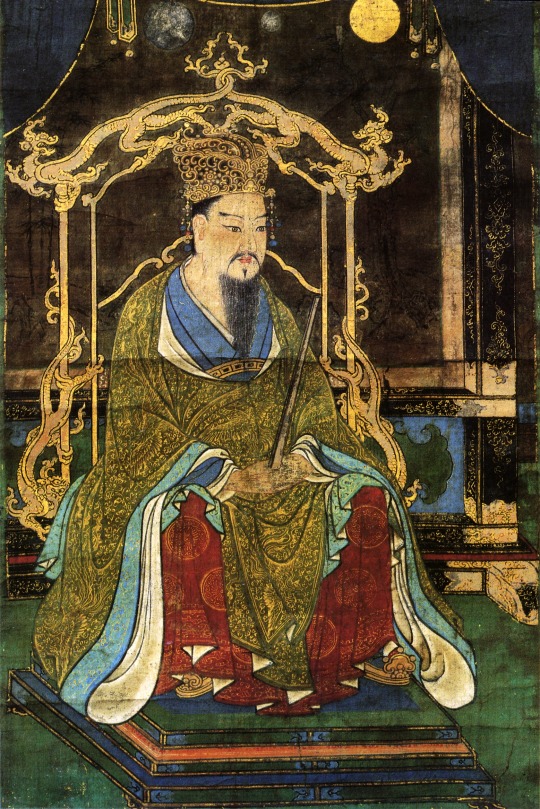
A sixteenth century painting of emperor Kanmu (wikimedia commons)
Since the oldest source to mention the taboo is an administrative, rather than religious, text, it is not impossible that it was intended by emperor Kanmu as a way to diffuse all these social and political tensions. Mark Teeuwen suggests his goal might have been a way to restore the prestige of his family and create a center of symbolic ancestral cult which would offer him additional legitimacy independent from the Buddhist establishment residing in Nara, which was crucial for many of the previous emperors. As a lifelong student of Confucian philosophy, he likely found many models to draw from in Chinese texts. His vision of Ise was presumably that of an ancestral mausoleum.
Regardless of Kanmu’s decisions, in the long run Buddhism retained its influence in royal affairs. In fact, it was arguably this emperor himself who indirectly caused its revitalization. In 804, he sent two young monks, Saichō and Kūkai, to China. They returned with something previously largely unknown in Japan: esoteric Buddhism. The new schools they established, Tendai and Shingon, captivated the imagination of virtually all strata of society in the nascent middle ages.
Amaterasu, too, came under esoteric Buddhist influence, and gained new roles, often completely detached from her earlier character - or at the very least from the part of it firmly tied just to the ruling family. Mark Teeuwen partially jokingly refers to this chapter in her history as an “escape” from Ise and notes that for a time she has “shaken off the imperial shackles”. There was a material aspect to these processes in addition to the purely theological considerations. In the Kamakura period, the role of warrior classes grew and the imperial court weakened. As a result, the Ise clergy - the Arakida clan of the Inner Shrine and the Watarai clan of the Outer Shrine - gained greater autonomy. The emperors weren’t able to enforce a symbolic monopoly on Ise, which therefore no longer served just as a center of ancestral cult. The downside was the loss of most of the imperial funding, which necessitated innovation to secure other sources of patronage.
The Ise taboos established earlier were not exactly abandoned, but the clergy found ways around them in order to enable Amaterasu to thrive in this new environment. A summary of the theological solution they developed is provided in Nakatomi Harae Kunge (中臣祓訓解; “Reading and Explanation of the Nakatomi Purification Formula) from the late twelfth century: “although on the surface performing ceremonies which are different from the Buddhist teachings, [Amaterasu] in essence protects the Buddhist laws.” Additionally, a myth reinterpreting one of the most famous episodes from the entire Buddhist canon, but with Amaterasu as a new protagonist, was developed to justify the taboo’s existence. I’ll discuss it in a separate section later on.
The reinvention was evidently successful. There is little evidence for widespread worship of Amaterasu in earlier periods. She was effectively little more than a royal deity. Even courtiers had limited, if any, knowledge of her. Only in the middle ages did she come to be widely recognized as a major figure in the Japanese religious landscape among all strata of society. Paradoxically it was the partial detachment from the imperial family that let Amaterasu claim a uniquely elevated position in the pantheon.
One of the best sources of evidence of Amaterasu’s newfound popularity are standardized oath formulas (起請文, kishōmon). In the Kamakura period, she came to appear in them quite frequently. She was invoked either simply as the foremost kami, or alternatively as the “lord of the land” (ie. Japan; 国主, kokushu). Either way, her purpose, much like those of other of the invoked figures, was to guarantee the oath will be upheld, and to punish those who will break it.
The spread of Amaterasu to new audiences resulted in the rise of numerous new interpretations. That’s where the already briefly discussed idea of honji suijaku came into play.
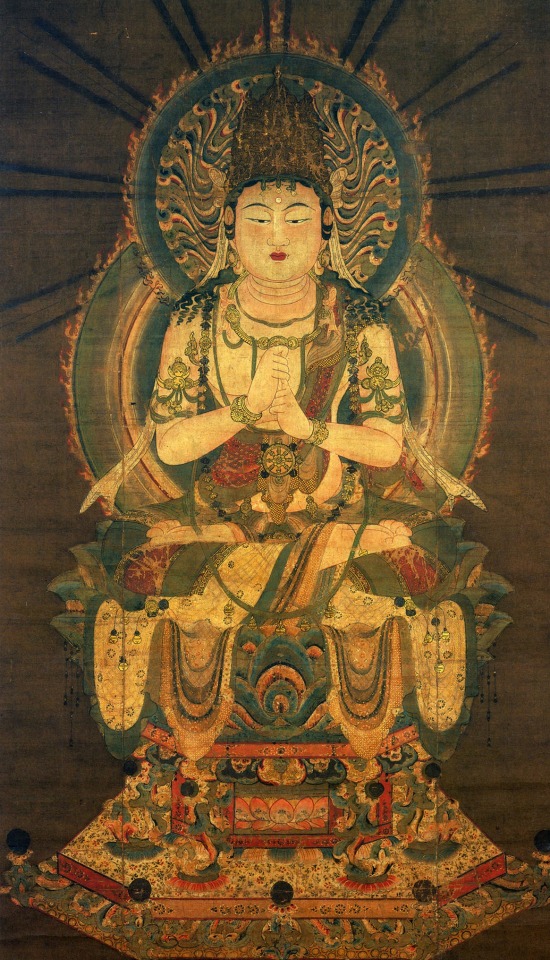
A twelfth century painting of the Buddha Dainichi (wikimedia commons)
As I said earlier, despite the popular understanding of this term honji suijaku did not necessarily just signify correspondences between kami and buddhas. However, in Amaterasu’s case the earliest example actually does match this model. She came to be associated with the Buddha Dainichi (大日, literally “great sun”; from Sanskrit Vairocana).
Some authors, like Bernard Faure, argue that the establishment of a link between Amaterasu and Dainichi was effectively the core of the early honji suijaku as a whole. Purportedly the belief that a connection existed between them went all the way back to the teachings of the famous monk Gyōki, active in the first half of the eighth century. The historicity of this claim is uncertain, but it was understood as historical truth in the discussed time periods, at the very least. Anna Andreeva, relying on earlier studies by Satoshi Itō, notes that it would appear Seizon’s (成尊; 1012–1074) Shingon Fuhō San'yōshō (眞言付法纂要抄; “An Abbreviated Compendium of the Transmission of Shingon Buddhism) from 1060 has a strong claim to being the oldest attested example which can be properly dated.
While other Buddhas, such as the historical Buddha, Amida (Amitābha), Miroku (Maitreya) or Yakushi (Bhaiṣajyaguru), are obviously also present in Japanese Buddhism, historically, especially prior to the rise of Amida-centrist schools, Dainichi was by far the most important one. This is especially pronounced in Shingon, where he is recognized as the “first Buddha” (Ādi-Buddha). Dainichi’s importance coupled with his solar associations made him a suitable match for Amaterasu in the eyes of theologians. Amaterasu’s solar role is pretty widely acknowledged in Buddhist sources, and she could be labeled as a “solar deity”, nisshin (日神). She was also identified with Nittenshi (日天子), the Buddhist version of the Hindu sun god Surya. However, Nittenshi could also function as a distinct figure and had his own iconography.
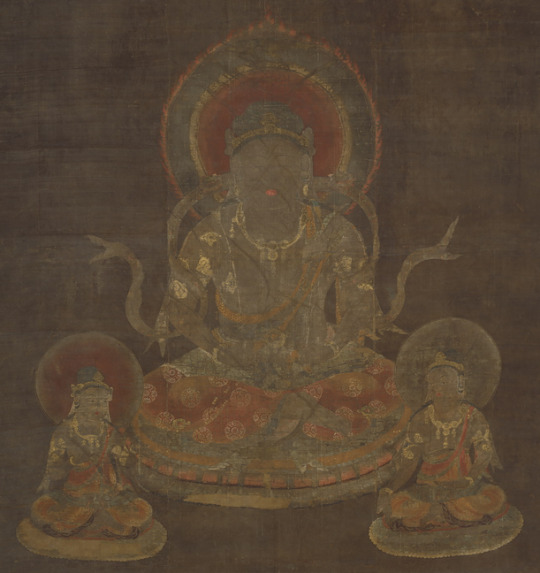
A twelfth century hanging scroll showing Nittenshi in the company of attendants (Kyoto National Museum; reproduced here for educational purposes only)
The development of a connection between Amaterasu and Dainichi brought a number of changes to Ise. As an extension of it, the Inner Shrine and Outer Shrine at Ise came to be identified with the Womb Realm mandala and the Diamond Realm mandala, closely associated with him.
The Ise clergy additionally argued that the taboo observed as the shrines does not impact Amaterasu’s connection to Dainichi - rather she (and by extension Toyouke as well) represents not a mere trace of this Buddha, but “original enlightenment” (hongaku). A new systematization of kami was built around the idea: at Ise, only Amaterasu and Toyouke were regarded as belonging to the category of “kami of original enlightenment”, with other divided into “kami of inception of enlightenment” (those who had to actively embrace Buddhism) and “kami of delusion” (those who opposed it). Similar categories were employed in different areas too, though, with the head local kami, for example Suwa Daimyōjin or Sannō (山王), taking the same role as Amaterasu at Ise. While Dainichi can be considered Amaterasu’s essential honji suijaku pair, I already pointed out, it was hardly unusual for a specific figure to develop multiple connections within the honji suijaku framework, though, and this holds true for her too.
Amaterasu, Enma and other functionaries of the underworld
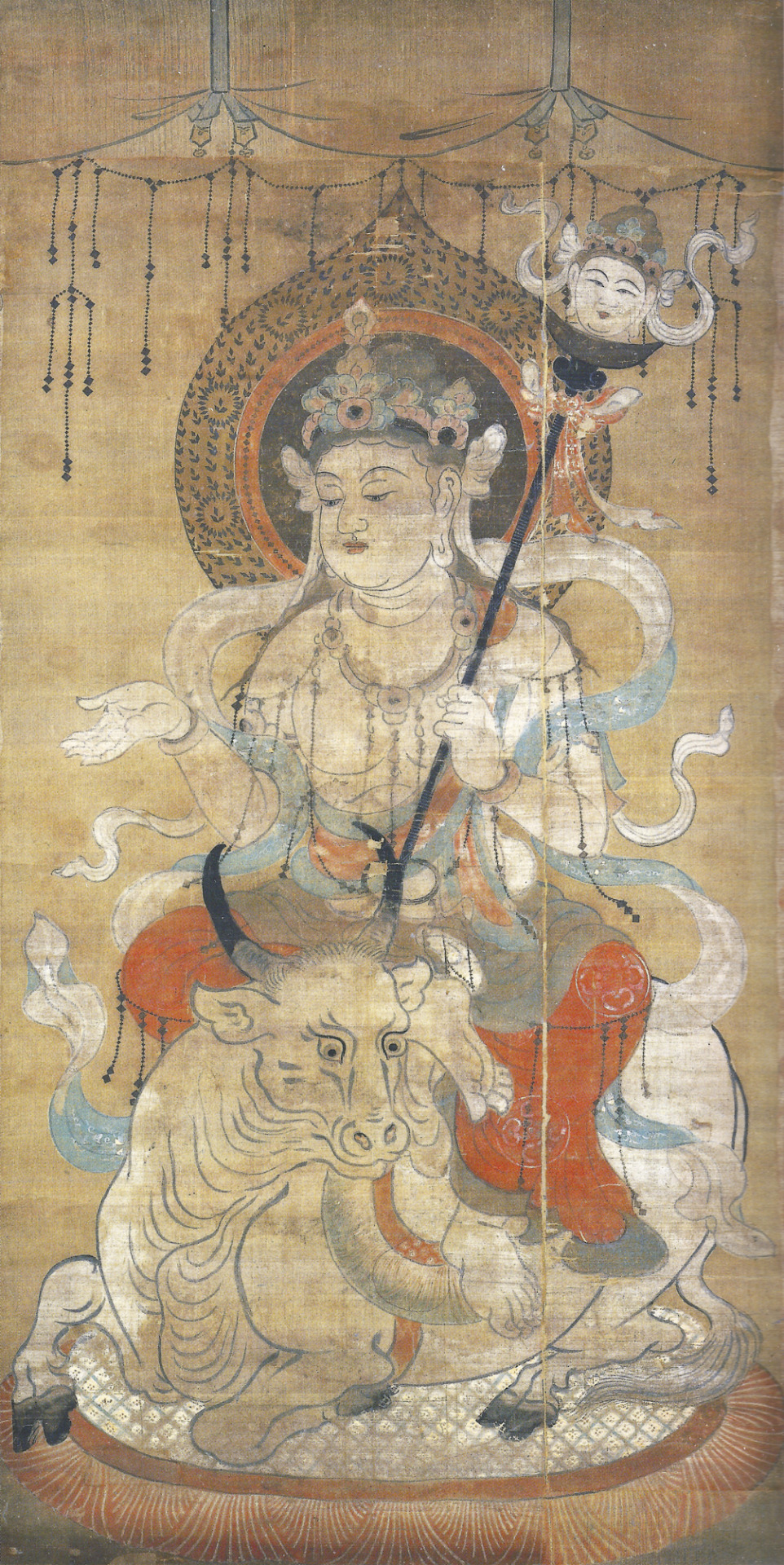
Enmaten (wikimedia commons)
Next to Dainichi, Amaterasu’s best attested Buddhist “counterpart” is not a Buddha, but rather a deva, specifically Enma, the judge of the dead. While many other devas present in Japanese Buddhism largely languish in obscurity today, at least in popular perception, he is probably the most recognizable one next to the Four Heavenly Kings, so I do not think much of an introduction is needed. Even if you are not particularly interested in the history of religions, chances are you’ve seen him in one piece of media or another.
Technically there are two distinct forms of Enma in Japanese tradition - Enmaten (焔摩天), who is more of a “classical” Hindu-style deva fairly similar in appearance to the original Yama, and the more popular Enma-ō (閻魔王; “king Enma”), styled after the bureaucratic Chinese underworld deities - but this distinction is not very important here. His rise to prominence in Japan started in the early ninth century at the latest, and by the ten century he was also joined by Taizan Fukun (東岳大帝; originally Taishan Fujun), a similar deity incorporated into Buddhism from Daoism. The latter was essentially the model for all of the other judges of the underworld: from the Buddhist kings of hell, to various local gods who took this role in the popular religion of Qing China. He might have even influenced the development of Matarajin in medieval Japan, but that’s a topic for another time.
It seems that a link between Amaterasu and Enma was initially established through an intermediary, specifically Seoritsuhime (瀬織津姫). She is identified with the king of hell in the Nakatomi Harae Kunge. While much about this text remains a mystery, in this case the logic behind the equation is quite clear - both of them were invoked during ritual purification. The means were not quite the same: Enma throws the sources of impurity into the deepest hells, while Seoritsuhime casts them into the ocean. Still, the level of similarity was sufficient to warrant establishing a connection.
Seoritsuhime is described both as a servant of Amaterasu, and as her aramitama (荒魂), literally “rough spirit”. This term designates the wrathful, or at least impulsive, aspect of a given kami. In Nakatomi Harae Kunge Seoritsuhime as a manifestation of Amaterasu is also more specifically described as ara-tenshi (荒天子), “heavenly emperor manipulating the brutish force”.
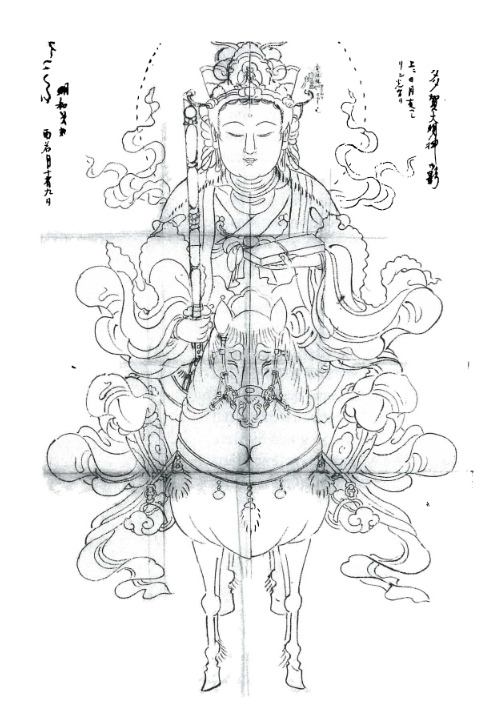
An Edo period depiction of Taga Myōjin from the collection of Kyoto City University of Arts (via Bernard Faure's Fluid Pantheon; reproduced here for educational purposes only)
Tenshō Daijin Kuketsu (天照大神口決; “Oral Transmission Pertaining to Tenshō Daijin”), a fourteenth century theological treatise, also embraces the equation between Enma and Amaterasu. It explains that he corresponds to the form of Amaterasu associated with the Taga shrine, Taga Myōjin (多賀明神). She has a distinct iconography, and fairly consistently appears as a horsewoman on either a black or white steed (always shown frontally), with a sword in one hand and a box with a sutra in the other. The same source also equates Amaterasu with Godō Daishin (五道大神; originally Wudao Dashen), the “god of the five paths”, another king of hell. In the Nakatomi Harae Kunge, it is instead a purifying kami, Haya-Akitsuhime (速秋津比売神), “the beloved of the dragon king Nanda”, who corresponds to him, though. The passage establishing this also mentions a similar link between yet another purifying kami, Ibukidonushi, and Taizan Fukun (curiously, the explanatory line states that the river where Izanagi purified himself after fleeing from Izanami is identical with Mt. Tai, the residence of Taizan Fukun). However, the latter is also said to be the aramitama of Toyouke.

A Japanese statue of Baozhi (Kyoto National Museum; reproduced here for educational purposes only)
Tenshō Daijin Giki (天照大神儀軌; “A ritual manual [for the worship] of Tenshō Daijin”) states that Amaterasu as a judge of the dead commands eleven messengers referred to as “princes”. It’s not easy to date this text precisely, though it’s clear it was already in circulation by 1164. It claims to contain knowledge originally revealed to the legendary Chinese monk Baozhi (寶誌; 418-524), best known from a legend commonly referenced in art in which he tears his face apart to reveal the visage of bodhisattva. The text effectively redefines Ise itself as a place where the underworld officials gather, imbuing the temple complex with new meaning, detached from its older role as a center of royal ancestor cult.
The eleven messengers listed are Zuikō Tenshi (a manifestation of Enma), Ryūgū Tenshi (dragon king Nanda), Suijin Tenshi (dragon king Batsunanda), Tenkan (“magistrate of heaven”), Chikan (“magistrate of earth”), Shimei (an underworld official), Inin Tenshi (equated with Izanagi and with Shiroku, an underworld official paired with Shimei in other sources), Kōzan Tenshi (Taizan Fukun), Godō Daishin, Kazenagashi no Kami and Okitama (a water deity equated with Suikan, “magistrate of water”). They correspond to various auxiliary shrines at Ise. Each of them is said to command a retinue of “four thousand trillion spirits”. While abstractly big entourages are quite common in medieval sources, from Michizane’s 105000 thunder god subordinates to Tenkeisei’s 84000 shikigami, even by these standards the number is unusually high.
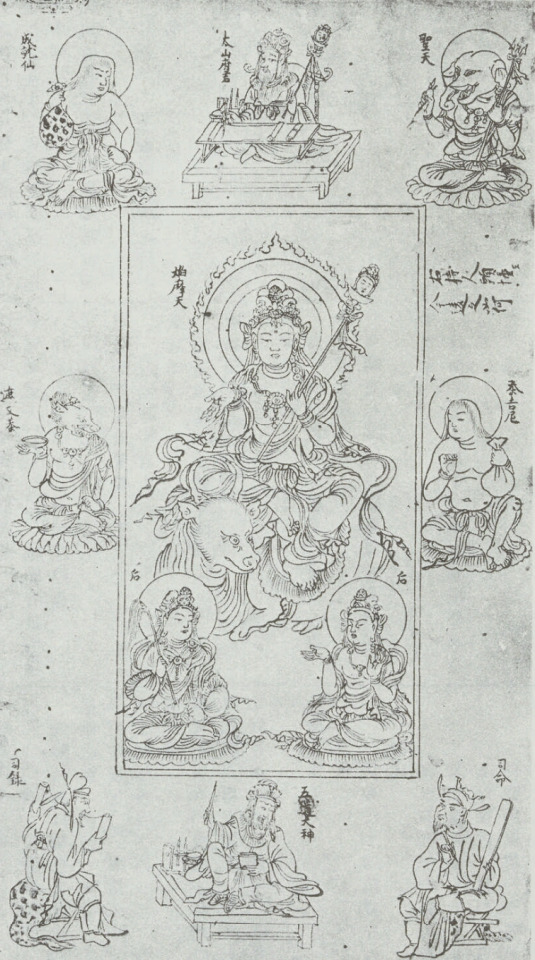
The Enmaten mandala, with Taizan Fukun (middle of the top row) and Shimei, Godo Daishin and Shiroku (bottom row) shown among his attendants (wikimedia commons)
The lists of underworld officials serving Amaterasu show a considerable degree of overlap with these present in ritual texts Enmaten Ku (閻魔天供) and Taizan Fukun no Sai (泰山府君祭; you may know it from the story of Tamamo no Mae). Notably, Tenkan, Chikan, Suikan, Shimei and Shiroku are all members of Enma’s entourage in origin. The last two are scribes responsible for keeping track of human lifespans, but the role of the former three is not well understood.
Another deity present both in these rituals and in Amaterasu’s entourage, Godo Daishin, is a king of hell in his own right. His origin is unclear, though the oldest sources which mention him are Chinese apocryphal episodes from hagiographies of the historical Buddha. As the “god of the five paths”, he is responsible for assigning the dead to one of the five realms of rebirth: these of gods, humans, animals, hungry ghosts or hell. Notably missing is the asura realm, which didn’t particularly catch on in East Asian Buddhism. In the oldest sources, he is portrayed as somewhat inept and after meeting the Buddha implores him to teach him how to fulfill his role better. Enmaten Ku and Taizan Fukun no Sai attained a considerable degree of popularity in the eleventh and twelfth centuries due to the spread of the bureaucratic image of hell, and many laymen sought Buddhist monks (in the case of the former ritual) and onmyōji (in the case of the latter) who could perform them. They were supposed to heal illnesses, prolong life, secure an easy birth or simply to guarantee good fortune. It’s not impossible that furnishing Amaterasu with a similar role to their central deities was meant to let her clergy from Ise capitalize on the popularity of such rituals too. The spread of the new image of Amaterasu as a judge of the dead was also likely tied to her judiciary role in the already discussed oath formulas, where she essentially acts as a supernatural enforcer of legal claims.
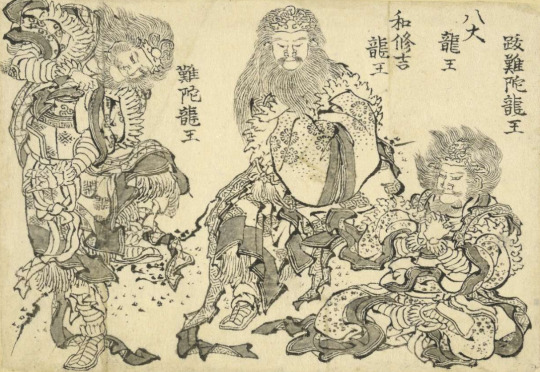
Hokusai's drawing of three dragon kings, including Nanda and Batsunanda (British Museum; reproduced here for educational purposes only)
The final matter that needs to be addressed here is the presence of dragon kings Nanda (難陀) and Batsunanda (跋難陀; Sanskrit Upananda) in Amaterasu’s underworld entourage. In contrast with their peers, they do not have anything to do with Enma. In Buddhist cosmology, they support the cosmic mountain Sumeru, on which the highest devas like Indra and Brahma reside. More context on their connection to Ise is provided in the treatise Bikisho (鼻帰書), which cites the Outer Shrine priest Tsuneyoshi Watarai (度会常昌; 1263-1339) as its source. It actually states that all eight of the dragon kings are protectors of Ise, though also that only two, one blue and one white (with no names provided), can be used to represent respectively the Inner Shrine and the Outer Shrine. The connection is said to depend on their role as protectors of the Womb Realm and Diamond Realm mandalas. Multiple sources from Ise indicate they were believed to dwell under the central pillars of the Inner Shrine and the Outer Shrine, in this context additionally identified with the cosmic abode of the gods, Mount Sumeru.
Amaterasu, Toyouke and Brahma (times two)
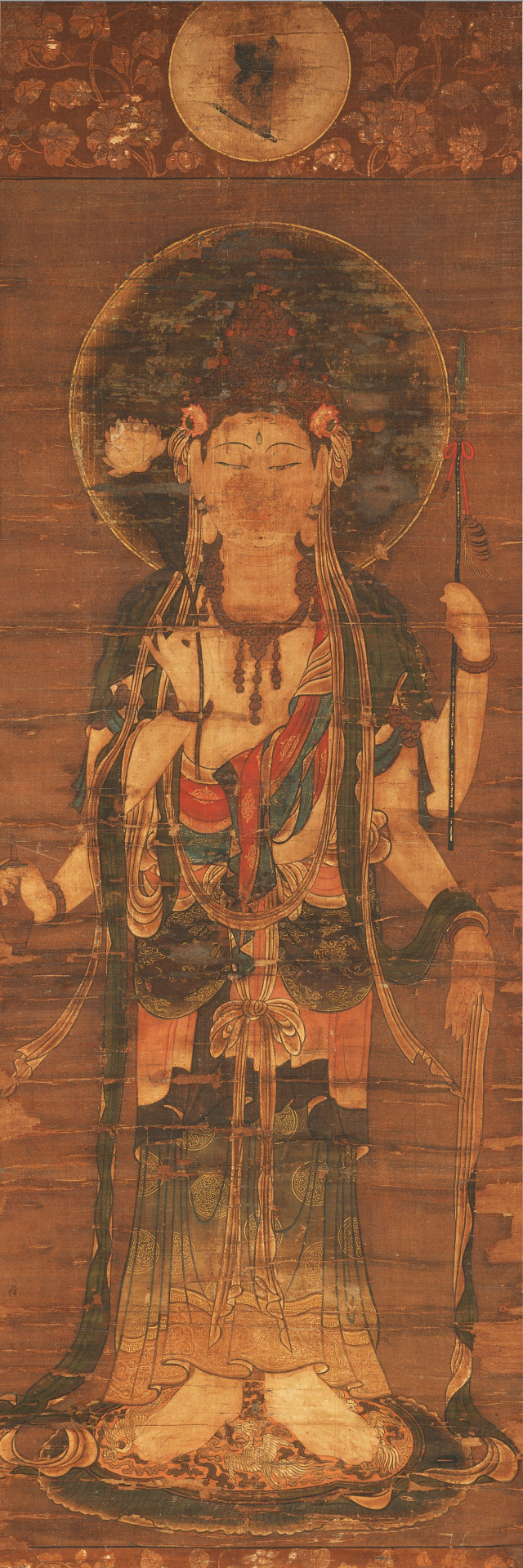
Bonten, the Japanese version of Brahma (wikimedia commons)
While Dainichi made a natural match for Amaterasu, and the reasons behind her association with Enma, while less obvious, aren’t hard to understand either, the third Buddhist figure most commonly associated with her, Bonten, is quite surprising. This deity, the Japanese Buddhist guise of Brahma, has limited presence in popular understanding of Buddhism, but generally much like his Hindu forerunner he is portrayed as a distant deity with limited interest in everyday human affairs. And yet, in medieval Japan Brahma was identified with a figure both commonly worshiped and understood as quite active.
This tradition is documented in Tenshō Daijin Giki. It reaffirms that Amaterasu - seemingly treated as a male figure in this case - is the Japanese guise of Dainichi. However, in the “Realm of Form” - a Buddhist term referring to the world inhabited by humans and deities - he takes the guise of Bonten, and acts as the deva king of Japan. His life will last a total of 105000 years, and he will defend exactly 1000 rulers over the course of this period, before ascending to the Realm of Form to hear the preaching of Miroku. He will also help the faithful reach it.
The already discussed Tenshō Daijin Kuketsu also recognizes the equivalence between Amaterasu with Bonten, though it also furnishes her with a similar connection to the other ruler of the devas, Taishakuten (Indra), and states that both of these equations depend on the doctrine of Abhidharmakośa. Perhaps more unexpectedly, the same work also equates Amaterasu with Shōten (聖天, literally “noble god”; a Japanese form of Ganesha), specifying that this reflects a Shingon view. However, the thirteenth century scholar Ieyuki Watarai (詳細表示; 1256-1356) in his Jingi Hishō (神祇秘抄; “Secret Comments about the Deities”) mentions a different tradition in which this god’s connection with Amaterasu is less direct. He is said to be identical with a nameless “heavenly fox” (天狐, tenko) who acts as her acolyte.
Yet another text already brought up in the previous section, Nakatomi Harae Kunge, does not equate Amaterasu with Brahma outright, but it does redefine terms from classical mythology around him. The High Plain of Heaven (高天原 Takamagahara) is said to be identical with the “First Meditation Heaven of the Realm of Form, ruled by Bonten”. Furthermore, the collective label Yaoyorozu no Kami (八百万の神; literally “eight myriad kami”) is said to encompass “Bonnō, Taishaku, the innumerable devas, the four Great Heavenly Kings, the innumerable devas of Bonnō, and eighty four thousand kami.”
The newfound interest in Brahma in the middle ages reflected an intellectual development arguably unparalleled in earlier Japanese religious tradition - a preoccupation with cosmology.
Kojiki and Nihon Shoki obviously do deal with this topic, but the relevant sections are incredibly brief. This new discourse about cosmology was, at its core, Buddhist, but a major issue was that Japanese Buddhism was not very concerned with cosmology either. The two main sources of inspiration were, therefore, not contemporary Buddhist literature, but Chinese (mainly Daoist) texts on one hand, and accounts of Hindu cosmology, especially the Puranas, preserved in Buddhist sources on the other. Figures such as Pangu, the Three Pure Ones, Shiva or Brahma as a result attained considerable renown among Japanese theologians, who reinterpreted myths about them to suit local context, creating new narratives in the process.

A contemporary statue of Kuni no Tokotachi (wikimedia commons)
In some cases the poorly defined primeval kami from classical mythology could be incorporated into the new visions of cosmology created in the middle ages. Ame no Minakanushi from the Kojiki and Kuni no Tokotachi present both in this work and the Nihon Shoki are both well attested in that context, though references to Ame Yuzuru Hi Ame no Sagiri Kuni Yuzuru Hi Kuni no Sagiri from the Sendai Kuji Hongi can be found too. They were effectively treated as almost interchangeable, or as stages of emanation of the same entity, as documented for example in the writings of the Tendai monk Jihen (慈遍).
Two strains of cosmological speculation, these focused on Brahma and primordial kami, were in particular enthusiastically embraced by the Outer Shrine clergy at Ise, who utilized both of them to improve the standing of Toyouke. As I mentioned before, her role, while seemingly initially relatively minor, grew with time. In many regards, she came to be presented as Amaterasu’s equal. She was furnished with an association with the moon to match Amaterasu’s solar character, for example. The first attempts at elevating Toyouke through theological speculation weren’t necessarily grand in scale. She was simply identified with other kami of similar characters every now and then, for example with Uka no Mitama. An isolated source, a letter from the early Kamakura period, appears to present her identical with Ninigi, Amaterasu’s grandson, instead, but this evidently did not stick.
A breakthrough occurred in the late thirteenth century. The outer shrine clergy developed a view that Toyouke didn’t originate as a servant brought in to deal with Amaterasu’s loneliness and other needs, but rather a primordial kami, identical with Ame no Minakanushi or Kuni no Tokotachi. Toyouke in this guise was the foremost kami of heaven, and Amaterasu “merely” the foremost kami of earth. However, as I already pointed out, the new cosmologies which influenced this reinterpretation of Toyouke depended not only on classical mythology. Therefore, the Outer Shrine’s kami could also be identified with Brahma, or credited with controlling the proper flow of qi and thus yin and yang, following a Daoist model. Much of this theological speculation might have originated in the works of a single priest, Yukitada Watarai (度会行忠; 1236-1305), though he was far from the only contributor.
It’s worth pointing out that there was a practical material component to the theological speculation about the identity of Toyouke. Regardless of the relation of their respective kami, Inner and Outer Shrine were ultimately rivals competing for patronage. To present Toyouke as equally, if not more, important as Amaterasu was also a way to make potential donors, from shoguns to commoner pilgrims, more inclined to support the Outer Shrine. While prior to the Kamakura period Ise could securely depend on imperial funding alone, that changed with the weakening of the court. Therefore, securing new supporters was vital for their continuous activity. This remained the case through the Edo period as well, but this topic obviously goes beyond the scope of this article.
Identification of both Toyouke and Amaterasu as Brahma was not necessarily contradictory thanks to the existence of sources in which more than one Brahma appears. Nobumi Iyanaga points out that two Brahmas, Mahābrahmā Śikhin (ie. Brahma as the king of the gods) and Mahābrahmā Jyotiṣprabha (“Great Brahma of Brilliant Light”), appear in the Yamato Katsuragi Hōzanki (大和葛城宝山記), with one reflecting traditional portrayals of Brahma and the other representing a reinterpretation of an account of Vishnu as a creator figure. Both of the titles used appear in the enumeration of deities listening to the Buddha’s teachings in the Lotus Sutra. Two Brahmas also appear in the Bikisho, where “king Brahma” descends from heaven, but instantly starts longing for a friend. In response, a deity named Harama, an alternate transliteration of Brahma into Japanese, appears to him. The notion of Toyouke and Amaterasu being two Brahmas might have developed in the thirteenth century at Senkūin, a Buddhist temple closely affiliated with the Ise shrines. A text from this location dated to between 1240 and 1275 states that Toyouke, addressed as identical with Ame no Minakanushi, corresponds to Shiki Daibontennō (尸棄大梵天王; “emperor Mahābrahmā Śikhin”) and Amaterasu to Kōmyō Daibontennō (光明大梵天王; “emperor Mahābrahmā Jyotiṣprabha”). It also specifies Toyouke is male and Amaterasu female, which reflects splitting Brahma into a male-female cosmogonic pair. Nobumi Iyanaga points out the theological treatise Tenchi Reikiki (天地麗気記) goes a step further: the two deities are said to partake in intercourse. He suggests this represents a development of the motif of Brahma longing for a friend in the Bikisho. Tenchi Reikiki also states the couple personifies the Womb Realm and Diamond Realm.
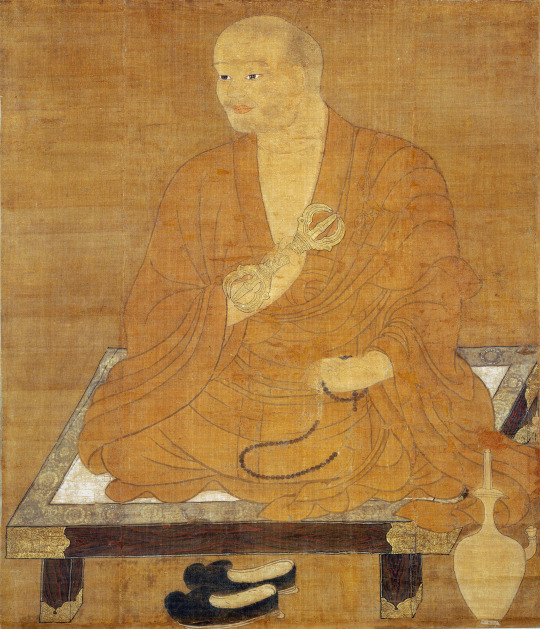
A Kamakura perioid painting of Kūkai holding a vajra (wikimedia commons)
As a digression it’s worth pointing out that while the Tenchi Reikiki was only written in the Kamakura period, it was actually attributed at the time to Kūkai, who lived centuries earlier. Obviously one reason was that there’s no better way to make a treatise seem more authoritative than to claim it was written by a celebrated historical figure. However, it’s also worth pointing out that at some point a connection between Kūkai and Amaterasu developed. A tradition known from a number of works, for example Monkan’s treatise Himitsu Gentei Kuketsu (秘密源底口決) presents him as a manifestation of her.
The Watarai theories about the nature of Toyouke and Amaterasu have originally been written down in the Kamakura period in the so-called “secret books''. This term has been used to refer to them collectively since the Edo period, when they were standardized for a relatively brief time into a “canon” of sorts. While tradition has it that there were five of them, research revealed the existence of further texts in medieval tradition, with one rediscovered in 1955, for example. At least in theory, the individual Watarai books present information contained within as a special sort of secret, designated by the Buddhist term shōgyō (聖教; literally “sacred teachings”). Originally it referred to the teachings of the historical Buddha, or to the Buddhist canon more broadly, but in medieval Japan the term came to refer to specific kinds of knowledge transmitted by monks and other religious specialists in general.
While sometimes referred to as “secrets” in English, shōgyō were not necessarily impossible to share. Through the entire middle ages, many temples and shrines all across Japan effectively actively built their identity around making it known that they possess religious secrets worth knowing and can transfer them. Sometimes, they were intentionally “leaked” to nobles, imperial courtiers or fellow clergymen to spark interest. They were also utilized in annual “debate rituals” (論義会, rongie) held by authorities for religious scholars, who treated them as a way to hone their rhetorical skills and gain new theological insights.
The divine and the vulpine at Ise: Amaterasu, Dakiniten and Sankoshin

The Dakiniten mandala (wikimedia commons)
The topic of shōgyō is fundamentally linked with ambivalent Buddhist figures which in medieval Japan came to be associated with the notions of non-duality combining enlightenment and ignorance, such as dakinis, which commonly figured in such “secrets”. While dakinis do not appear in the cosmological myths from the Watarai books, they nonetheless did play a role in the developments pertaining to medieval Amaterasu. A link between her and the dakini par excellence, Dakiniten, developed due to their shared connection with Dainichi. Under his original name Mahavairocana, Dainichi can be portrayed as a subduer of dakinis, taking the guise of Mahakala (Makaraten) in this context. The singular Dakiniten as a result of this association could be identified with Dainichi outright, as attested in the Rinnō Kanjō Kuden (輪王灌頂口傳), dated to the late Kamakura period.
The link between Amaterasu and Dakiniten is chiefly known from the Shingon ritual sokui kanjō (即位灌頂), “enthronement initiation”, meant for emperors freshly ascended to the throne. It was first performed for emperor Fushimi in 1287, and remained a part of ascension ceremonies all the way up to 1846. In this context, Amaterasu outright appears in the guise of Dakiniten. A similar statement can be found in Tenshō Daijin Kuketsu, which calls Dakiniten the honji of Amaterasu (it also links Dakiniten with Fujiwara no Kamatari and the rise of the Fujiwara clan, but I’ll cover that elsewhere in the future).
Keiran Shūyōshū specifies that the shinko was an appropriate form for Amaterasu because it is the only animal capable of emitting light on its own. This ability in turn reflects the fact that its body was identical with the wish-fulfilling jewel, a frequent attribute of Buddhist figures; the name is self-explanatory. Alternatively, the animal could be described as possessing three tails, each ending in a wish-fulfilling jewel. By the fourteenth century, this object was firmly associated with Amaterasu as well. This led to the development of the view that Nyoirin Kannon (如意輪観音), a form of Kannon directly linked to the wish-fulfilling jewel, was Amaterasu’s honji. The shinko similarly could be identified with this bodhisattva. Granted, so were prince Shotoku, Ryōgen and numerous other figures, but that’s a separate topic not directly relevant to this article.
A different belief developed around the shinko at Ise. Here this supernatural animal came to be identified with Sankoshin (三狐神), literally “three fox deity” or “three fox deities”. Despite the triplicity implied by the name, sources such as Tamakisan Gongen Engi (玉置山権現縁起) clearly describe Sankoshin as a singular figure who acted as the “king of the heavenly foxes” (天狐王, tenko-ō).
It is presumed that Sankoshin's name was in origin a derivative of Miketsu no Kami (御食津神), the kami of Miketsu, the granary of the Outer Shrine. The development of Sankoshin might have started as a misreading or wordplay, with Miketsu (御馔津) transformed into the homophone mi ketsu, “three foxes” (三狐). This phrase in turn can be alternatively read as sanko, as in the case of Sankoshin.
Miketsu no Kami is otherwise associated, or outright identified, with Uka no Mitama, who is obviously not a fox, let alone three foxes; or alternatively with Toyouke, who has even less to do with these animals; you might recall she is described as a miketsu kami in the legend of her arrival in Ise. Older copies of Nakatomi Harae Kunge also affirm this equation, but later on the reference was substituted for a statement supporting the equivalence between Toyouke and Ame no Minakanushi favored by the Watarai priests.
Sankoshin in the middle ages appeared in rituals from Ise associated with the kora (originally 子良, later also 狐良). This term refers to a class of female shrine attendants associated with the Outer Shrine at Ise. Jingi Hishō asserts they were manifestations of Dakiniten, and on the basis of homophony links their name with 狐 (ko), “fox”.
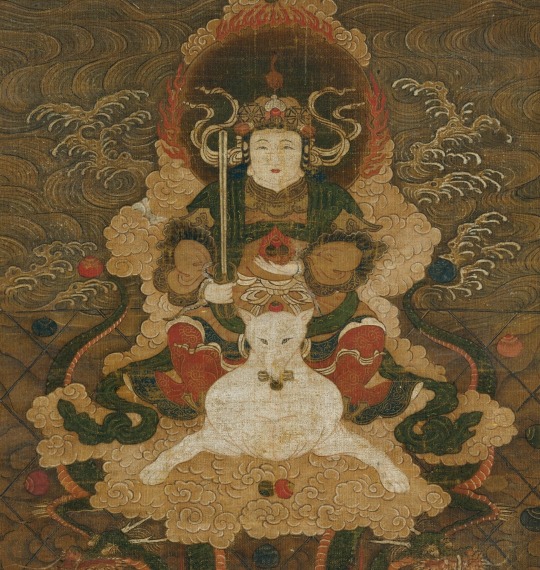
Part of a hanging scroll depicting Dakiniten riding on a fox (wikimedia commons)
Elsewhere, shinko is treated as another name of Dakiniten, or alternatively of her fox mount (which lacks serpentine traits proposed by Teeuwen, but sometimes does have snakes coiling around its legs and neck). It’s also a part of her well attested epithet Shinko-ō Bosatsu (辰狐王菩薩), “Bodhisattva King of Astral Foxes”. This connection is also partially responsible for the development of another of her titles, Shindamani-ō (真陀摩尼王), “king of the wish-fulfilling jewel”.
Being able to grant specific wishes immediately was commonly attributed to Dakiniten in the middle ages and beyond. However, due to her ambivalent perception and peripheral role between devas and demons in Buddhist theology it was commonly believed that the worldly benefits granted by her do not last and in the long run might lead to misfortune. With time, related rituals often came to be perceived negatively, often based on highly dubious reasons, as I discussed recently in another article. The ambivalent perception of Dakiniten ultimately was not unlike that of the animals she came to be associated with.
I plan to cover Dakiniten in more depth at some point, but I will only note here that her connection with foxes has a rather interesting history. Originally, dakinis were associated with jackals in India, due to their similarly unfavorable perception. When Buddhist texts dealing with this topic were transmitted to China, references to these animals posed a challenge to the translators, who were entirely unfamiliar with them. Based on context it was established that the name of a fox-like legendary animal, the yegan (野干), would make for a sensible translation. Since the yegan was described as fox-like, and since foxes in general had a major role in religion and literature of China at the time, eventually comparisons with foxes started to show up. Most notably, in the Tang period Śūraṅgama Sūtra the word dakini is provided with the gloss humei gui (狐魅鬼), something like “fox sorceress demon”. While unique, this term might have influenced the development of the image of dakinis in general, and Dakiniten in particular, in Japan.

A thirteenth century depiction of Benzaiten with entourage (wikimedia commons)
To go back to the core topic of this section, the development of a link between Amaterasu and Dakiniten had one more consequence: the establishment of a similar connection between Toyouke and closely related Benzaiten at Ise, to keep the theme of mirroring associations. This goddess is the Buddhist form of Saraswati. Today, she is best known as one of the Seven Gods of Luck, who emerged as a group in the Edo period, though her history goes further back and she enjoyed considerable popularity through the middle ages.
Outside of Ise, it was commonly Amaterasu herself rather than Toyouke who came to be linked to Benzaiten. According to a legend which originated on Chikubu Island, Benzaiten first appeared in Japan during the reign of emperor Kinmei, and instantly announced she is a manifestation of Amaterasu. A less direct reference might be present in the already mentioned Taiheiki, where Yoshisada Nitta at one point says he heard Amaterasu at times manifests in the form of a “dragon god of the blue ocean”, which might be an allusion to a common symbol of Benzaiten.
Benzaiten and Amaterasu could also be associated without being identified with each other. In a myth tied to the tradition of wandering blind singers (a group traditionally believed to be under her protections), she effectively replaces Ame no Uzume, and lures Amaterasu out of the cave by playing her biwa. In the Asamayama Engi (朝熊山縁起), she is addressed as Amaterasu’s mother instead, though she ultimately only plays a minor role in contrast with her daughter. The text largely revolves around Amaterasu (as noted by Anna Andreeva portrayed here as a “great conversationalist”) explaining theological matters to the monk Kūkai.
Amaterasu, Aizen and sericulture

The wisdom king Aizen (Metropolitan Museum of Art)
In addition to her links to Buddhas and devas, Amaterasu also offers an example of identification between kami and wisdom kings. They enjoy an elevated position among Buddhist figures, almost on par with Buddhas and bodhisattvas. She could specifically be identified with arguably the second most important member of this category, Aizen Myōō. Since he is regarded as a wrathful manifestation of Dainichi, the reasons appear fairly straightforward. Linking him with Amaterasu goes back at least to Eison, a long-lived thirteenth century Shingon monk. The connection additionally reflects Amaterasu’s association with the wish-fulfilling jewel. Aizen was outright identified with this object, which is actually responsible for many of his own associations. Last but not least, Aizen and his fellow wisdom king Fudō were identified with the same two mandalas as the two shrines of Ise. On this basis it was not hard to link Aizen with Amaterasu.
However, once again, association does not necessarily equal conflation. Therefore, Aizen and Amaterasu could also appear as two distinct figures in the same sources. For example, both textual and iconographic instances of a triad consisting of both of them and another wisdom king, Fudō, are known. The occasional identification between Aizen and Amaterasu is not the reason behind his appearance here. Instead he and Fudō are present because they are an archetypal Buddhist dyad used to represent duality.
The triad is a medieval reinterpretation of the cave myth which played a role in an initiation rite (灌頂, kanjō) focused on Amaterasu. In this context both of the wisdom kings take the roles of “rock cave assistants”, with Fudō corresponding to Takuhatachijihime (the mother of Ninigi and younger sister of Omoikane) and Aizen to Tajikarao (who famously opens the cave in the classical version of the myth). The opening of the cave Amaterasu hid herself in was compared to the opening of the legendary Iron Stupa, said to exist somewhere in the south of India. This event, as Buddhist treatises record, led to the reveal of esoteric knowledge to the early Mahayana thinker Nagarjuna. In Tenshō Daijin Kuketsu, it is actually Amaterasu herself who was transmitted to him by the bodhisattva Kongōsatta (Vajrasattva).
To go back to the depictions of the Amaterasu triad, another thing worth pointing out is that a unique iconographic variant of her appears in them: seated on the back of a horse, with a solar disc and scales in her hands. While at a first glance this might sound similar to already discussed Taga Myōjin, there is actually a difference: the latter is always depicted frontally, not facing left, in contrast with the other mounted form of Amaterasu.

A depiction of Memyō from the fifteenth or sixteenth century (Metropolitan Museum of Art)
However, Bernard Faure notes these paintings resemble yet another figure she could be equated with, Memyō Bosatsu (馬鳴菩薩; “horse neigh bodhisattva”). This name originally referred to the Buddhist author Aśvaghoṣa, but in this context it instead designates a sericultural deity of Chinese origin first attested in the Tang period, for example in a short text attributed to Varjabodhi. However, while the Chinese original, Maming Pusa, is male, his Japanese counterpart is generally portrayed as a female figure, especially in texts stressing her connection to Amaterasu.
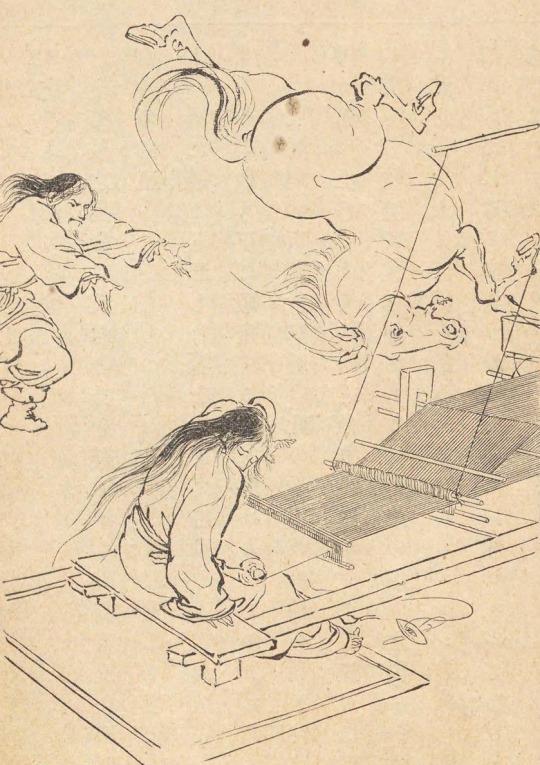
A Meiji period illustration of Susanoo throwing the carcass of Ame no Fuchikoma into Amaterasu's weaving hall (wikimedia commons)
Presumably the two initially came to be associated with each other because of their shared interest in sericulture and weaving. The classical myth portraying Amaterasu as a weaver, in which Susanoo throws the carcass of the horse Ame no Fuchikoma into the room where she is engaging in this craft, has been channeled to highlight why she would be identified with a deity portrayed on horseback.
While Memyō is arguably the highest profile Chinese figure Amaterasu was identified with (unless you want to make a case for Enma but that would be a bit of a reach), it’s worth noting that there’s another such case. However, it involved a historical figure rather than a deity. While presenting Buddhist patriarchs or rulers as manifestations of Buddhas or deities was par for the course, this one strikes me as quite unique.

Yang Guifei, as depicted by Shōen Uemura (wikimedia commons)
Jindai no Maki Hiketsu (神代卷祕決) records a tradition according to which Yang Guifei, a consort of emperor Xuanzong of Tang, was a manifestation Amaterasu. It depends partially on the preexisting belief that the former did not commit suicide, but instead escaped to Japan, and came to be enshrined in the Atsuta Shrine, which on the account of its picturesque location was sometimes identified with Penglai, the land of Daoist immortals. A related legend is recorded in the sixteenth century treatise Utaishō (謡抄), which relays that the Atsuta deity (here not identified with Amaterasu) manifested in China as Yang Guifei to seduce emperor Xuanzong to distract him with a plan of invading Japan. After accomplishing this goal, she returned to her shrine.
Emperor Xuanzong wasn't exactly the conventional nemesis of Amaterasu, whether in classical mythology or in the middle ages. I'll look into the figures such a title can be applied to in in the second half of this article; due to tumblr's limits I cannot publish both halves as a single post. The bibliography will also be included in part 2.
119 notes
·
View notes
Text

A busy month with a few highlights like the Dish podcast and, of course, the release of season 2 of The Responder.
May 1st
Martin was the guest star on the Dish podcast, together with Tony Schumacher.
Also available as full video.
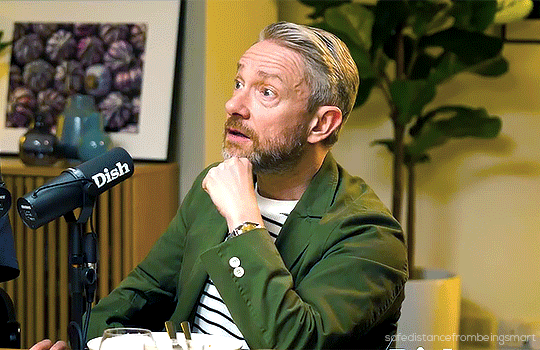
May 4th
A new interview in The Standard about season 2 of The Responder.
May 5th
The Responder is back! S2 is now available on BBC iPlayer.

May 6th
Tons of great reviews for s2 of The Repsonder, a short promo clip and a new project for Martin.
Also, a short tribute to Bernard Hill.
May 7th
Martin and the crew attend a special screening of The Responder in Liverpool.

May 9th
Martin was on the BBC The One Show.

May 12th
BAFTA time! Martin presented the award for Supporting Actress. And he looked great on the Red Carpet, of course. ( x ) thanks to @a-freemaniac ( x ) ( x )


May 13th
New lovely pics from last night ( x ) ( x ), a new red carpet video, Rachel sharing pics. 🥳 Also, this video.
Aaaand this video. So much. Woohoo.
May 14th
We finally learned which role Martin will play in the upcoming Momo film.
May 16th
The official Bafta photo has been released.

May 17th
Martin will read 1984 on BBC RADIO 4 soon.
May 21st
Martin Freeman attended The Prince's Trust and TKMaxx & Homesense Awards 2024.

May 22nd
Martin met King Charles today.
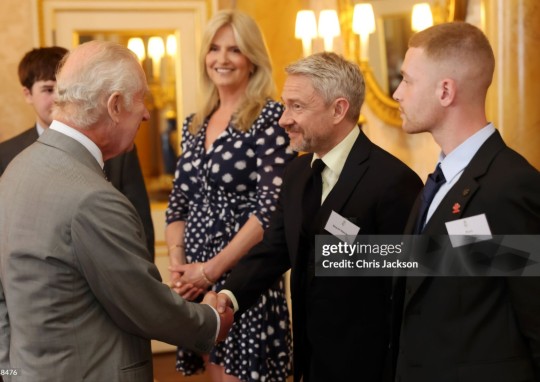
May 26th
We got to see a few BTS bits from The Responder and Rachel showed us Martin's backside.

Wow, that took a while to put together. Good! We can never have enough Martin.
Also, a shoutout to @a-freemaniac , who did an excellent job in providing us with new content when I was too busy running around London and with other RL commitments- please check out her blog!
Please let me know if you want to get tagged. 🙂
@missdeliadili
@oetkb12
@macgyvershe
@emaster875
@jobooksncoffee
@sunnysidesidra
@sherlockwatsons
@xeniawatson
@procrastinatorasfuck
@ratherbethedragon
@your-local-comedy-lawyer
@female-frodo-totally
@raphinsocks
@randomwholocker
@whatnext2020
@ribjork
@cortinita
@a-freemaniac
@chinike
@lilianaperezmx-blog
47 notes
·
View notes
Text
Happy Pride everyone!
This year, the server is doing a small month long challenge for our lovely writers and artists.
Each of the 4 weeks of June has a very general prompt (we've included some ideas if you have trouble thinking of anything, though you don't have to use those at all).
For the ARTISTS: do one (or more if you want to) quick piece of art per week surrounding he week's prompt. If you post them on tumblr, tag this blog (@batpham-discord-highlights) with your batpham server pride challenge art so we can reblog your creations!
For the WRITERS: do one (or more if you want to) piece of flash fiction (which is any piece of writing that is 1k or under) per week surrounding the week's prompt. We'll have an AO3 Collection for the event if you want to add your work. Of course if you post on tumblr as well, tag us and we can reblog it :D
Also: you're welcome to spend more time on your pieces, make it bigger/longer, or make more than just the one per week if you want to (this goes to both our lovely artists and writers), but the goal was just to have some quick, easy fun surrounding queer characters, identities, and relationships :>
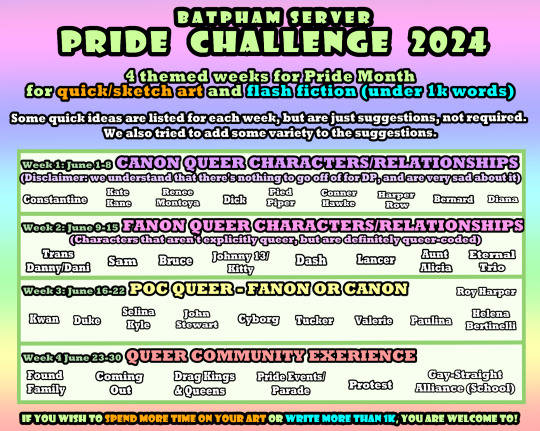
Image ID under the cut
Batpham Server Pride Challenge 2024
4 themed weeks for Pride Months for quick/sketch and flash fiction (under 1k words)
Some quick ideas are listed for each week, but are just suggestions, not required. We also tried to add some variety to the suggestions.
-----
Week 1: June 1-8 CANON QUEER CHARACTERS/RELATIONSHIPS
(Disclaimer: we understand that there's nothing to go off for DP, and are very sad about it)
Constantine, Kate Kane, Renee Montoya, Dick, Pied Piper, Conner Hawke, Harper Row, Bernard, Diana
Week 2: June 9-15 FANON QUEER CHARACTERS/RELATIONSHIPS
(Characters that aren't explicitly queer, but are definitely queer-coded)
Trans Danny/Dani, Sam,Bruce, Johnny13/Kitty, Dash, Lancer, Aunt Alicia, Eternal Trio
Week 3: June 16-22 POC QUEER- FANON OR CANON
Kwan, Duke, Selina Kyle, John Stewart, Cyborg, Tucker, Valerie, Paulina, Helena Bertinelli, Roy Harper
Week 4: June 23-30 QUEER COMMUNITY EXPERIENCE
Found Family, Coming Out, Drag Kings&Queens, Pride Events/Parade, Protest, Gay-Straight Alliance (School)
-----
If you wish to spend more time on your art or write more than 1k, you are welcome to!
#pride month#pride#dcxdp#dpxdc#batpham discord server#dp x dc#dc x dp#ignore me posting this on june 2nd#imagine is still june 1st
28 notes
·
View notes
Note
rank your family worst to best and explain why
oh shit. uhh like everyone-everyone? okay Cass: She's really awesome, she knows everything about anyone and if I were to cross her I'd be put into the ground instantly. She knows my secrets that I thought I buried deep ago but she somehow found the exact location where I buried everything and dug it up quicker then I could ever explain. Jason: Jason's actually pretty chill once you get to know him, he's awesome to be around and I love hanging out with him. Even if it's not often. He's a great cook and I love him a lot. I like watching him maneuver around the kitchen and my toxic trait is thinking I too could also do that.
Tim: He's a ball of stress and you just wanna squeeze him until he's unstressed. It doesn't work. I've never tried. But I would just assume it wouldn't work. He's really great at doing what he does and it impresses me every time I see him working on something he's really focused on. He's great to hang around! I like hanging out with his boyfriend, Bernard, 'cause the two of us are great with FNaF theories!
Damian: He's my favorite little brother, technically also my only little brother. But we're closer in age and I like watching him do his art stuff! He's a bit mean from time to time but that's okay. He's the one who inspired me to make my own little funky art things, you can see them all over my blog too!
Steph: She gets me, she understands me. I love her so much, she's practically my sister. She's great to hang out with and I love her sense of style. I look up to her and she's just always been so awesome!
Babs: She helps me out all the time, even if I don't ask her to. It's small things or big ones like helping me relocate my shoulder! She's great at computer stuff and watching her do her work is so awesome and so cool! She's always there for everyone and I love her for that. She's just amazing!
Bruce: He took me in, he's always been such a great guy, even though he's definitely had his low points, he's always trying. I really admire him for that. He's looking out for everyone as much as he can, making sure we're as safe as we can be and just overall doing his best as a father. Bruce has always been really awesome.
Alfred: I love Alfred so much. He's the best cook I've ever met, he's the best at taking care of everyone and he's always so nice. Except to people who aren't nice to him. Really as long as you're nice to him he's nice to you and he'll care about you and he'll take care of you. But even if he doesn't like you, he'll still take care of you. He's a really great guy, I wish everyone had someone like Alfred. I wish Alfred had an Alfred for himself, he needs to take care of himself. I do my best to take care of him. But sometimes I'm just not enough.
Kate: I've only met her a handful of times. But every time I've met her she just is so cool. I love her hair, it's so pretty, Her sense of style is amazing and I'm really glad to have her as my aunt. Helena Wayne: I love her so much, she's my sister. I care about her a lot. She's great to be around and I'm always so happy to be included by her! She's one of the best!
Carrie: I've never really known much about her, but she's always been so cool to me. I love her sense of style she's so fun from what I hear and I like her from what I know
Jarro: He's a starfish, I love that. He's so awesome and He's so creative and I think that everyone deserves to see him or get to meet him!
Okay so I guess I didn't really rank them, but these are reasons why I really like them so much. Does that count?
20 notes
·
View notes
Text
My headcanons that make Bernard actually an interesting character
My main Bernard headcanon is that he has a "conspiracy" blog. He actually posts vital information about superheros on his blog, and he is a bit anti the whole hero thing. He is not a detectiv in the traditional way. He befriends different people and buys information. He is more of an actor, creating characters and accents. Bernard makes fun of hero's and hopes people would know more about their work and how many victims their fights have. He started to cover up his blog as a conspiracy one after doing juvi at 13 for some suicide squad mission leaks. He thinks he is an actual jurnalist unlike others who publish only what the guvernamant wants them to.
He speaks multiple languages. That helps him blend better in the gotham underworld.
He is not actually American he just lives within his mother side of the family as his parents also have some legal problems. He wants to hide that they are not his parents as not to raise eyebrows about his and his parents' "criminal" history.
Bruce openly doesn't like him, like he doesn't most guys tim has thing for, and hopes he gets back together with steph. And when he finds out about his past posts on the batfam, he finally has something against Bernard. Dowd stopped updating any batfam news after he started dating tim.
30 notes
·
View notes